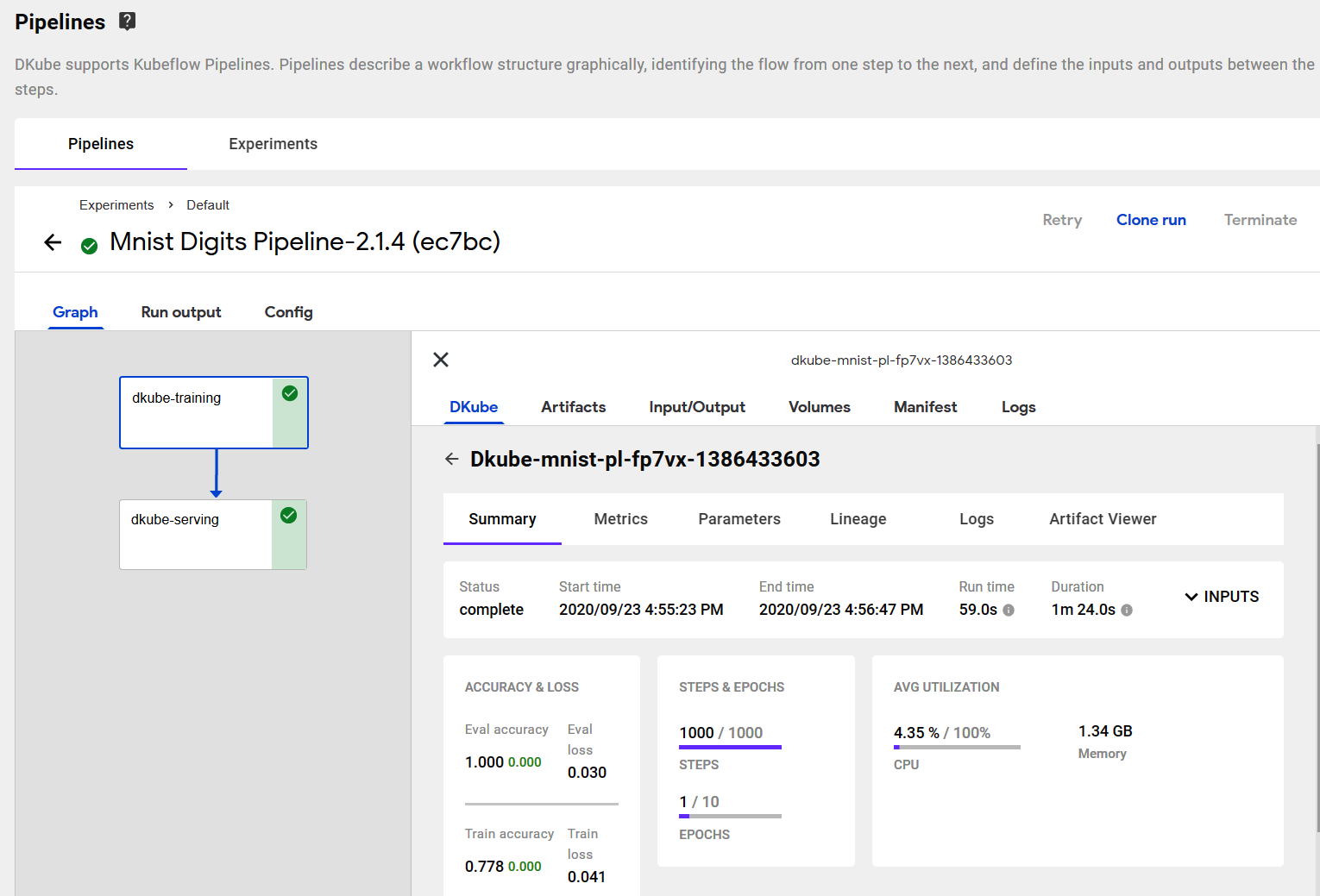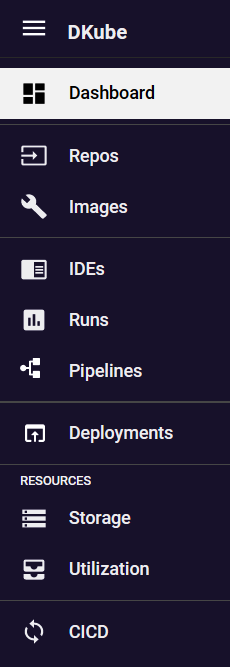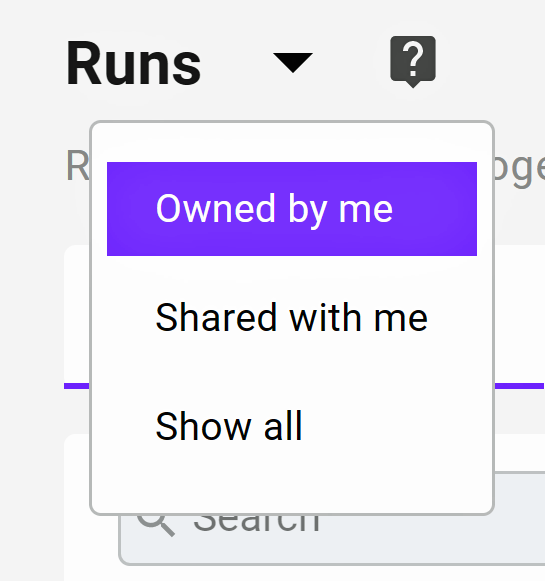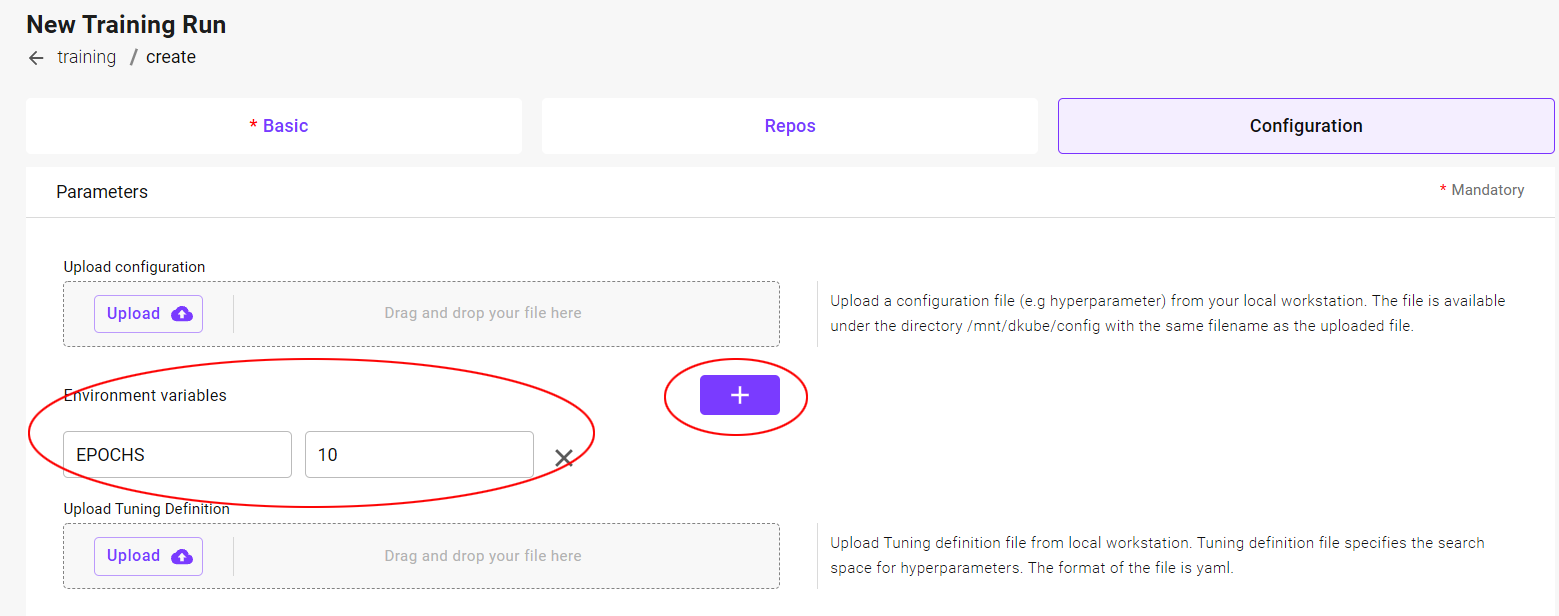Data Scientist Dashboard & Workflow¶
Data Science Dashboard¶
The Data Science dashboard provides an overview of the current state of the workflow.

From the dashboard, the user can go directly to recent jobs.
Data Science Workflow¶
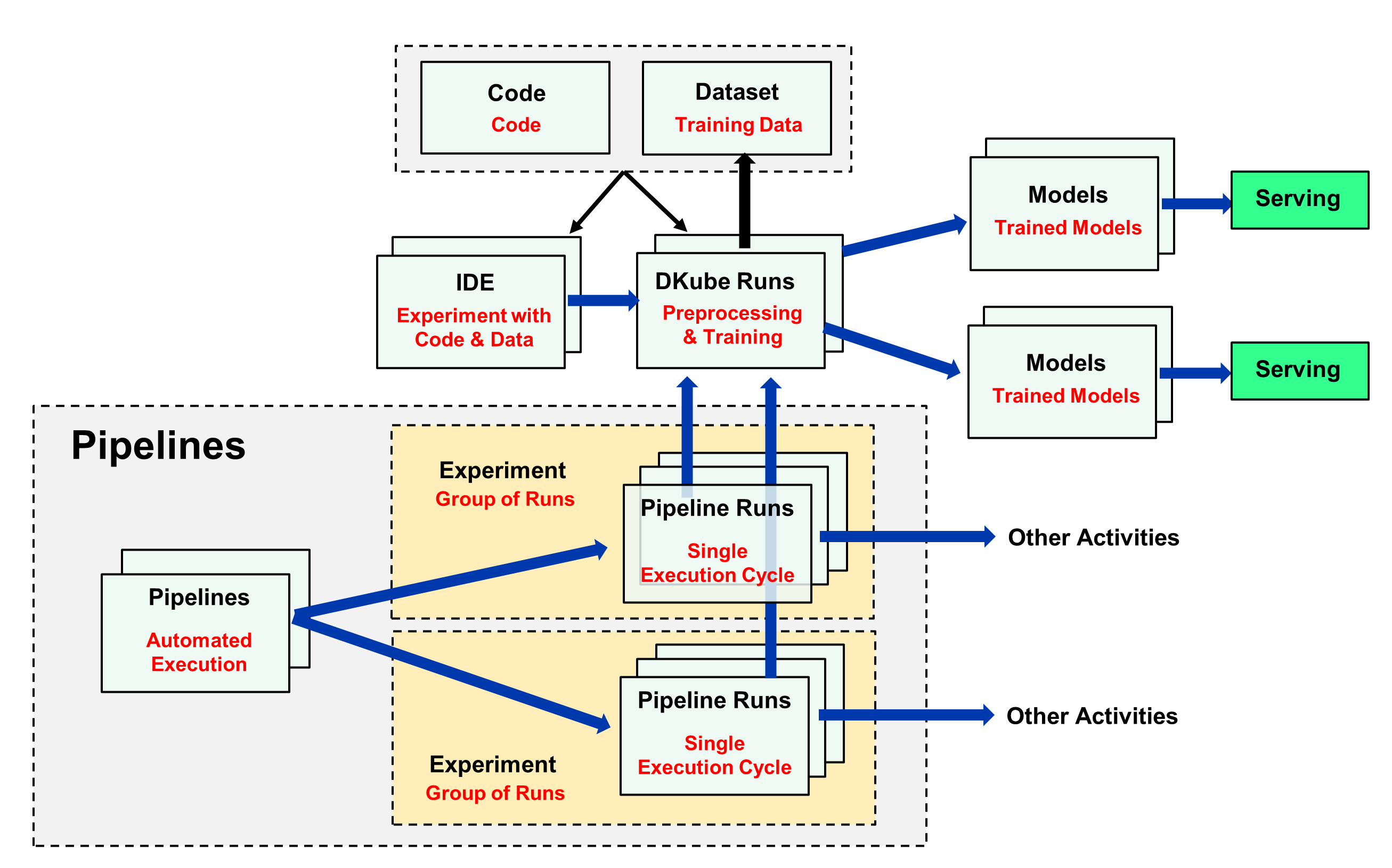
Function |
Description |
|---|---|
Code |
Folder containing the program code for experimentation and training |
Dataset |
Folder containing the datasets for training |
Model |
Trained model that can be used for inference or transfer learning |
DKube Run |
Execution of DKube training or preprocessing code on dataset |
IDE |
JupyterLab or RStudio |
Pipeline |
Automated execution of a set of steps using Kubeflow pipelines |
Pipeline Run |
Single execution run of a Kubeflow Pipeline |
Experiment |
Group of Pipeline runs, used to enable better run management |
Images¶
DKube provides an image catalog that stores images for use in IDEs and Runs. The images can be added from an external source or built from a Code repo. The custom images will appear in the Image dropdown menu when creating an IDE or Run.

Add an Image¶
An image can be added to the image catalog by selecting the “+ Add Image” button on the top right. A popup appears with the necessary fields.

Field |
Value |
|---|---|
Name |
Unique user-chosen identification |
Image URL |
URL of image |
Description |
Optional, user-chosen field to provide details about the Image |
Private |
Select if the Image requires a Username and Password |

Build an Image¶
An image can be built from an existing Code repo using the CI/CD mechanism as described at CI/CD Image Creation
Building an image is accomplished by selecting the “+ Build” button in the button on the top right. A popup appears with the necessary fields.

Field |
Value |
|---|---|
Code |
Available Code repos |
Git URL |
Repository that contains the Code & Build instructions |
Commit ID |
Commit ID of the Code repo - latest if blank |
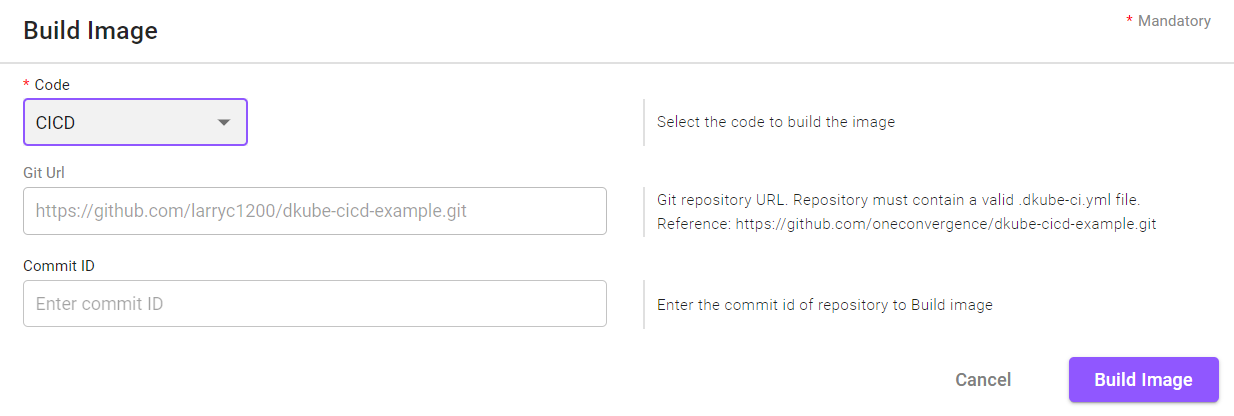
Repos¶
There are 3 types of repositories under the Repo menu item : Code, Datasets, and Models.
In order to use them, they must first be accessible by DKube. There are different ways that the repositories can be accessed. These are described in more detail in the sections that describe each input source.
They can be uploaded to the internal DKube storage area. In this case, the data becomes part of DKube and cannot be updated externally.
They can be accessed as a reference pointer to a folder or file. In this case, the files can be updated by an external application and DKube will access the new version of the file on the next run.
Versioned vs Non-Versioned¶
Datasets & Models¶
The Dataset & Model repos can be optionally managed by the native DKube DVS versioning system, as explained at Versioning. When repos are created, the source selections guide whether the repo is part of the versioning system or not.
Note
The Datasets & Models need to be versioned with the DKube DVS system in order to be part of the full MLOps architecture. They can then be tracked in the lineage system, compared, etc.
Program Code¶
Code is not versioned within the native DKube system. It is normally developed and versioned in an IDE, then committed to a GitHub repository.
The behavior of which version of the code gets used depends upon whether it is being used by an IDE or a Run.
IDE |
The latest version of the product code will always be used. This is the case even if there is a specific commit ID filled in. The commit ID will be ignored. |
Run |
The code is uploaded into the local DKube storage based on the Commit ID field. If the Commit ID field is blank, the latest version of the code will be uploaded. If there is a specific GitHub Commit ID in the field, that version of the code will be uploaded and used. |
Code¶

The program code is contained in folders that are available within DKube to train models using datasets.
The Code screen provides the details on the programs that have been downloaded or linked by the current User, and programs that have been downloaded by other Users in the same Group.
The details on the code can be accessed by selecting the name. The details screen shows the source of the code, as well as a table of versions.

Add Code¶
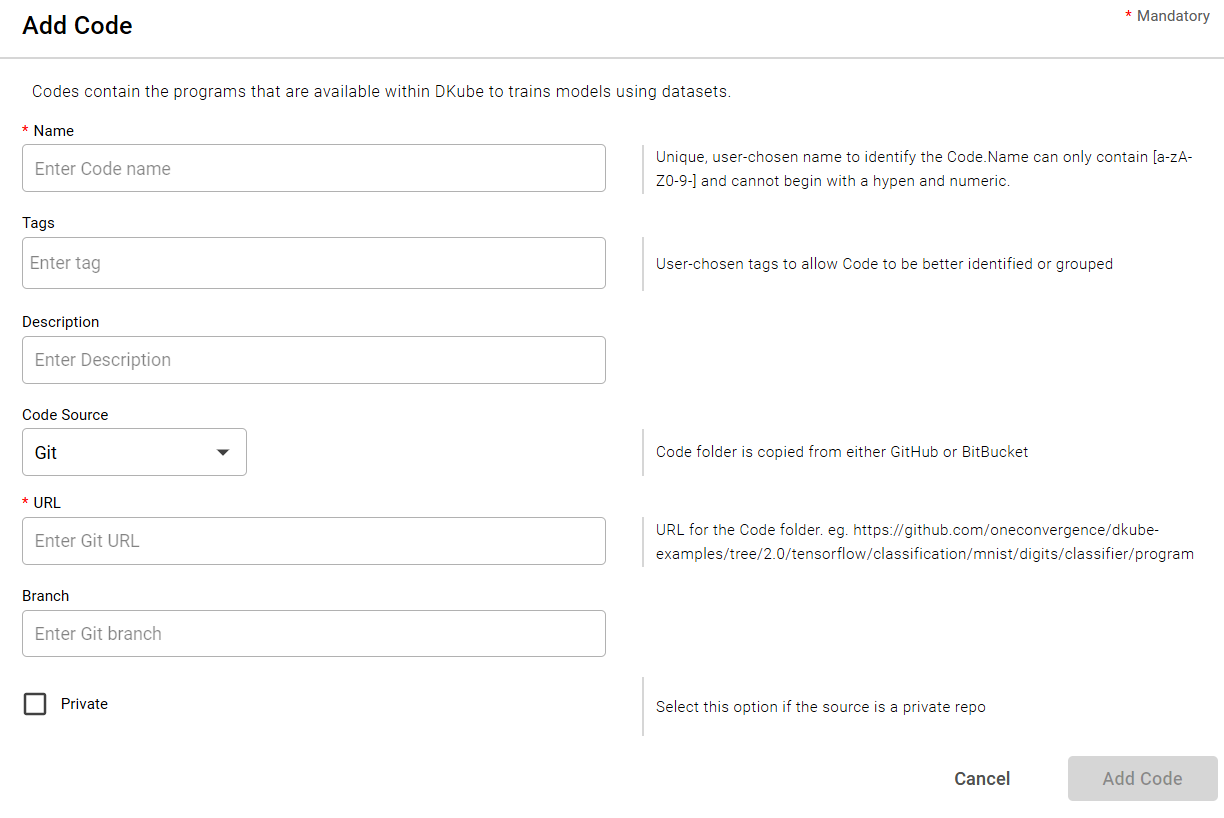
In order to add a code folder, and use it within DKube:
Select the “+ Code” button at the top right-hand part of the screen
Fill in the information necessary to access the code
Select the “Add Code” button
Fields for Adding Code¶
The input fields for adding code are described in this section.
Field |
Value |
|---|---|
Name |
Unique user-chosen identification |
Tags |
Optional, user-chosen detailed field to allow grouping or later identification |
Description |
Optional, user-chosen field to provide details about the Code |
Git¶
The Git selection creates a code folder from a GitHub, GitLab, or Bitbucket repo folder.
Access Type |
Uploaded to local DKube storage |
Field |
Value |
|---|---|
URL |
url of the directory that contains the program code |
Private |
Select this option if you need additional credentials to access the repo |
Bitbucket Access
When accessing a Bitbucket repository, the following url forms are supported.
url |
Authentication |
|---|---|
Authentication with username and password |
|
Authentication with ssh key |
|
Authentication with ssh key |
The following links provide a reference on how to access a Bitbucket repository:
Bitbucket Set Up Key Reference 1
Bitbucket Set Up Key Reference 2
Private Authentication
When selecting a Private repo, more options are provided to enter the credentials. There are 3 different methods to enter credentials:
ssh key
Username and password
Authentication token
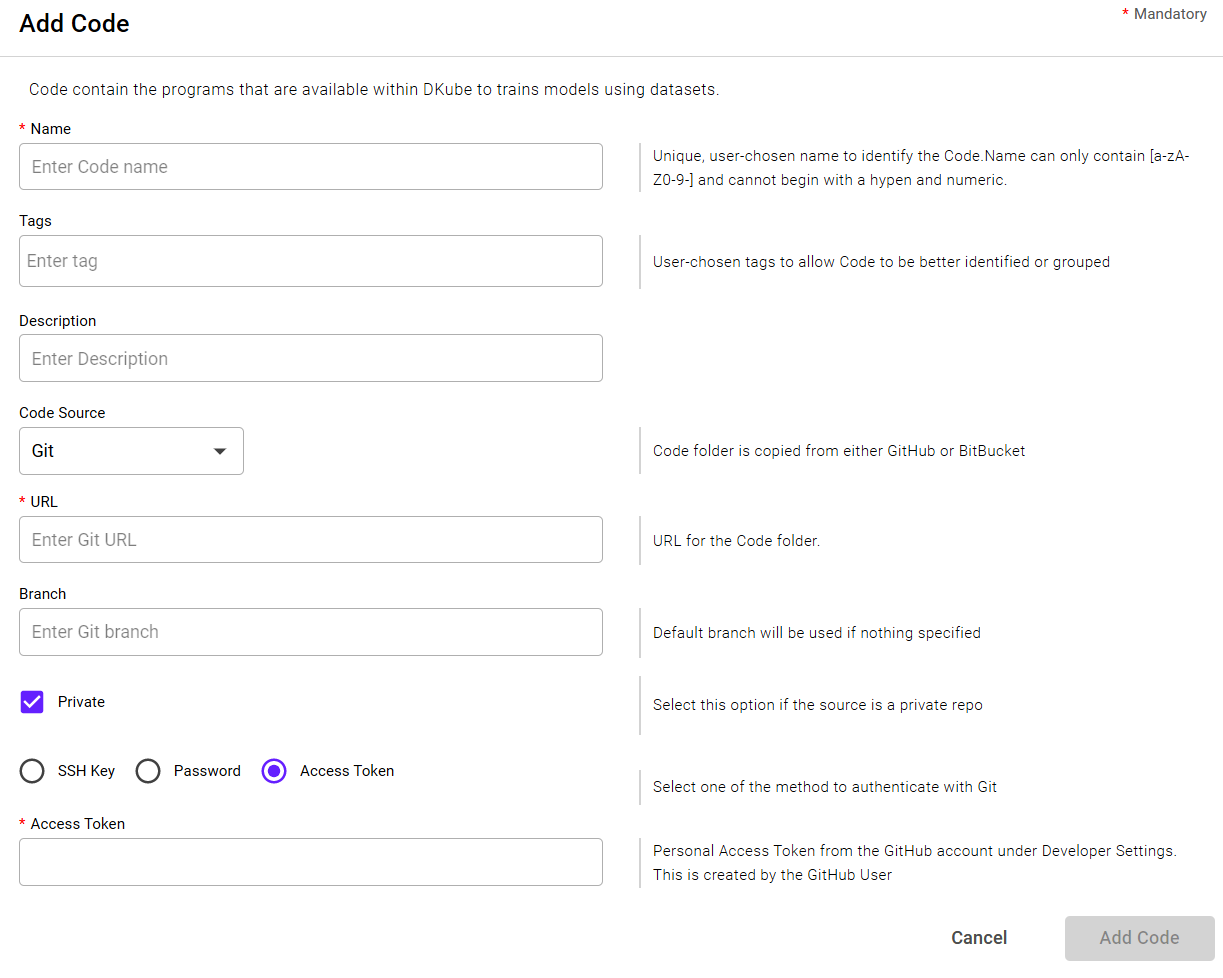
When using an ssh key:
The public key should be copied to the repository server
The private key should be copied to the local workstation, and uploaded from there
Note
DKube supports the pem file format and the OpenSSH & RSA private key formats
The following link provides a reference on how to create a GitHub token: Create GitHub Token
Note
The last set of credentials for each host and credential type will be saved in an encrypted form internally, and prepopulated in the fields
Delete a Code Repo¶
Select the Code to be deleted with the left-hand checkbox
Click the “Delete” icon at top right-hand side of screen
Confirm the deletion
Datasets¶

The Datasets contain the training data. Datasets can be added to DKube in the following ways:
Manually added for use as an input for a run with or without versioning capability, as explained in Versioning
Manually added as a placeholder for use as a versioned output
Created as an output from a preprocessing run
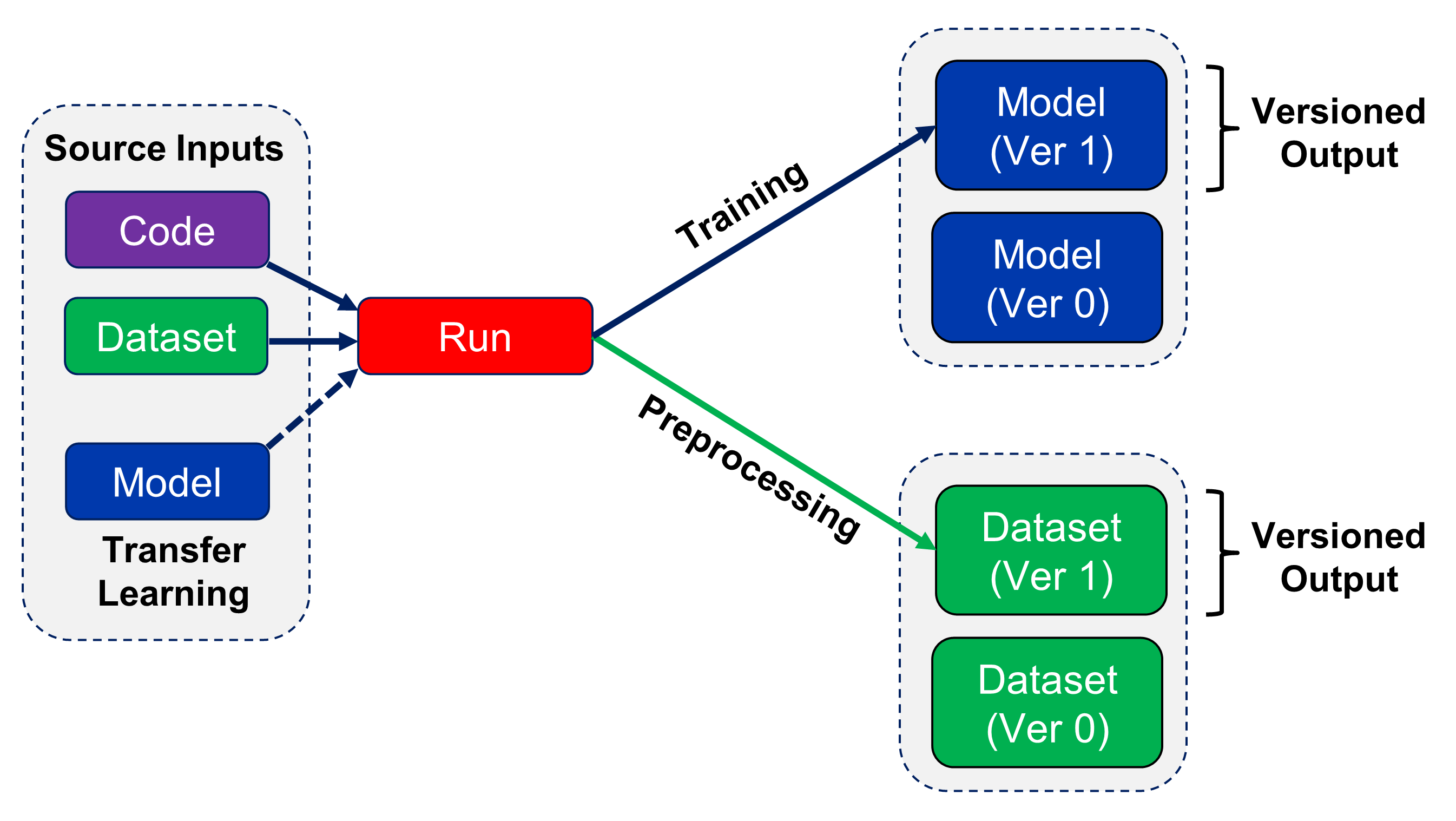
DVS provides a way for DKube to track versions within the application, and is explained at Versioning . To use this option, the DVS name will need to be created, as described in DVS. This will set up the metadata and data storage locations. A default DVS storage is created when DKube is installed.
Dataset Details¶
The details for the Dataset contain information about where it came from, where it is stored, and the versions.
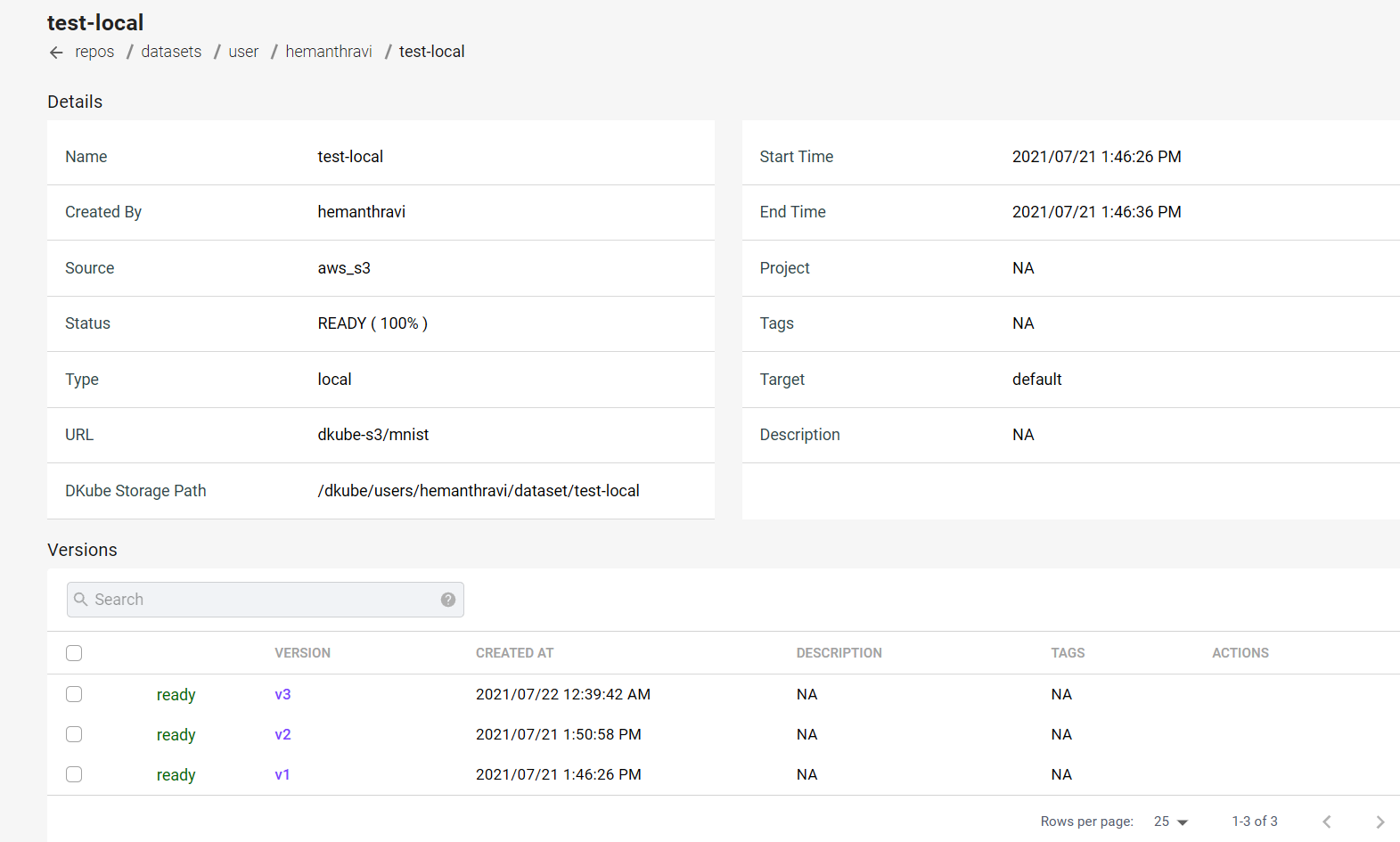
Dataset Version Detail¶
Selecting the version of a Dataset brings up a screen that provides more details on that version, including a list of the Runs that use that version.

The Dataset can be downloaded to your local file system from this page from the “Export” button at the top right.
Dataset Version Lineage¶
If the Dataset was created as part of a Preprocessing Run, selecting the “Lineage” tab of the Dataset will provide the full lineage. This provides all of the inputs that were used to create the Dataset.

Add a Dataset¶
The input fields for adding the Dataset depend upon the source.
Datasets Used for Training Input¶
A Dataset that is intended as the input to a training run can be added with or without versioning capability. For this type of usage, the fields should be filled in as follows:
Field |
Value |
|---|---|
Versioning |
DVS or None, based on whether versioning is selected |
Dataset Source |
From dropdown menu |
Note
The dataset source field will show different options depending upon whether versioning is selected. Some input sources are only compatible with versioning, and others are are only compatible without it

Datasets Used for Preprocessing Output¶
A new Dataset that is intended as an output for a preprocessing run must first be added in the Dataset repo as a blank (version 1) entry. A new version of the same Dataset will be created by the preprocessing run. For this usage, the fields should be filled in as follows:
Field |
Value |
|---|---|
Versioning |
DVS |
Dataset Source |
None |
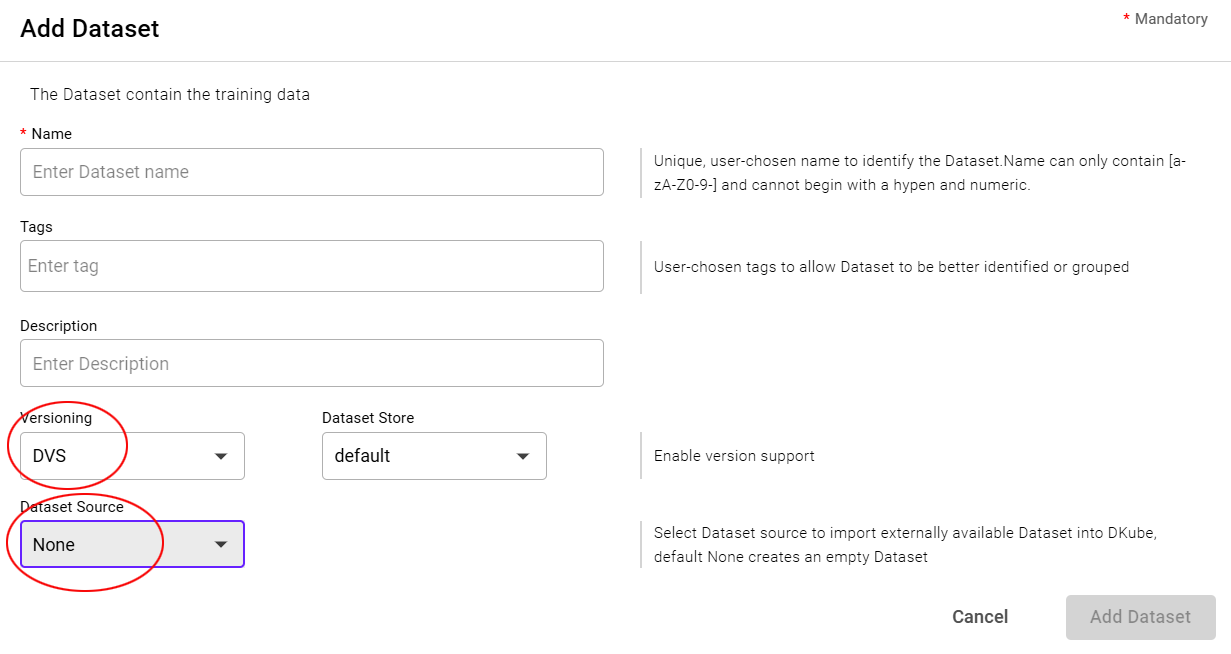
Adding the Dataset¶
In order to access a Dataset, and use it within DKube:
Select the “+ Dataset” button at the top right-hand part of the screen
Fill in the information necessary to access the Dataset
Select the “Add Dataset” button
Fields for Adding a Dataset¶
For all inputs there are common fields.
Field |
Value |
|---|---|
Name |
Unique user-chosen identification |
Tag |
Optional, user-chosen detailed field to allow grouping or later identification |
Description |
Optional, user-chosen field to provide details about the Dataset |
The fields for specific data sources are as follows:
The Git selection creates a Project from a GitHub, GitLab, or Bitbucket repo folder.
Access Type |
Uploaded to local DKube storage |
Versioned with DVS |
Yes |
Field |
Value |
|---|---|
URL |
url of the directory that contains the Dataset |
Branch |
Branch within the Git repo |
Private |
Select this option if you need additional credentials to access the repo |
Note
If the branch of the rep is contained within the url, the Branch input field can be left blank. If the Git repo does not have the branch in the url, the Branch input must be filled in to identify it.
Bitbucket Access
When accessing a Bitbucket repository, the following url forms are supported.
url |
Authentication |
|---|---|
Authentication with username and password |
|
Authentication with ssh key |
|
Authentication with ssh key |
The following links provide a reference on how to access a Bitbucket repository:
Bitbucket Set Up Key Reference 1
Bitbucket Set Up Key Reference 2
Private Authentication
When selecting a Private repo, more options are provided to enter the credentials. There are 3 different methods to enter credentials:
ssh key
Username and password
Authentication token
When using an ssh key:
The public key should be copied to the repository server
The private key should be copied to the local workstation, and uploaded from there
Note
DKube supports the pem file format and the OpenSSH & RSA private key formats
The following link provides a reference on how to create a GitHub token: Create GitHub Token
The fields are compatible with the standard S3 File System. The files can be:
On AWS
On an S3-compatible Minio server ( https://min.io/)
Access Type (DVS) |
Uploaded to local DKube storage |
Access Type (non-DVS) |
Referenced |
Field |
Value |
|---|---|
AWS |
Check this box if the Program is on AWS |
Endpoint |
If not AWS, url of the Minio server endpoint |
Access Key ID |
https://docs.aws.amazon.com/general/latest/gr/aws-sec-cred-types.html |
Secret Access Key |
https://docs.aws.amazon.com/general/latest/gr/aws-sec-cred-types.html |
Bucket |
https://docs.aws.amazon.com/AmazonS3/latest/dev/UsingBucket.html |
Prefix/Subpath |
Folder within the bucket. If the bucket is called “examples”, and it has a sub-folder called “mnist”, with a further sub-folder called “dataset”, the syntax for this field is “mnist/dataset”. |
The GCS input selection will use Google Cloud Storage.
Access Type |
Uploaded to local DKube storage |
Field |
Value |
|---|---|
Bucket |
Bucket name |
Prefix |
Relative path from the bucket to the specified folder |
Secret Key |
JSON file containing the GCP private key |
DKube can access a k8s persistent volume created for the user.
Access Type |
Referenced |
Field |
Value |
|---|---|
Volume |
Persistent volume directory created for user |
The NFS input option allows a cluster wide nfs server to be the source of the data.
Access Type |
Referenced |
Field |
Value |
|---|---|
Server |
IP address of the nfs server (e.g. 192.168.200.1) |
Path |
Absolute path to the dataset on the nfs server (e.g. /mnt/dkube/mnist) |
The Redshift input option allows DKube to access Amazon Redshift as the source of the data.
Note
Use of Redshift within DKube is described at Amazon Redshift
Access Type |
Referenced |
Field |
Value |
|---|---|
Endpoint |
The Redshift IP address & port from the Redshift/Clusters screen under the Properties tab (e.g. http(s)://<IP>:<Port>). This field is optional when using an API server. If the field is not filled in for an API server, the endpoint is retrieved for the specified database name. |
Database |
Database Name |
Username |
Master User Name |
Password |
Master User Password |
Cert |
Optionally upload a CA certificate from your local workstation if required to validate the server’s certificate |
This input source provides the ability to access a Dataset from other sources. The sources are:
Any public url
A file from the user’s local workstation
Access Type |
Uploaded to local DKube storage |
Field |
Value |
|---|---|
URL |
Public URL for access to the directory |
Select File |
Select the file to be uploaded |
Extract uploaded file |
Check this box to extract the files from a compressed archive |
Note
The Workstation input source will upload a single file. In order to upload multiple files in one step, an archive file (.tar, tar.gz, .tgz, or .zip) can be created that combines the multiple files into one. If the uploaded archive file is a combination of multiple files, the checkbox Extract upload file should be selected. DKube will then uncompress the single archive file into multiple files. If the “Extract upload file” is not checked, the archive will be treated a single file, with the assumption that the model code will use it as it is.
Delete a Dataset¶
Select the Dataset to be deleted with the left-hand checkbox
Click the “Delete” icon at top right-hand side of screen
Confirm the deletion
Models¶

The Models Repo contains all of the models that are available within DKube. Models are added to the DKube repo in the following ways:
Manually added for use as an input for a run that includes transfer learning with or without versioning capability, as explained in Versioning
Manually added as a placeholder for use as a versioned output
Created as an output from a training run

The versions of each model can be viewed by selecting the expansion icon to the left of the Model name. This allows direct access to the version details, and for versions of different models to be compared.
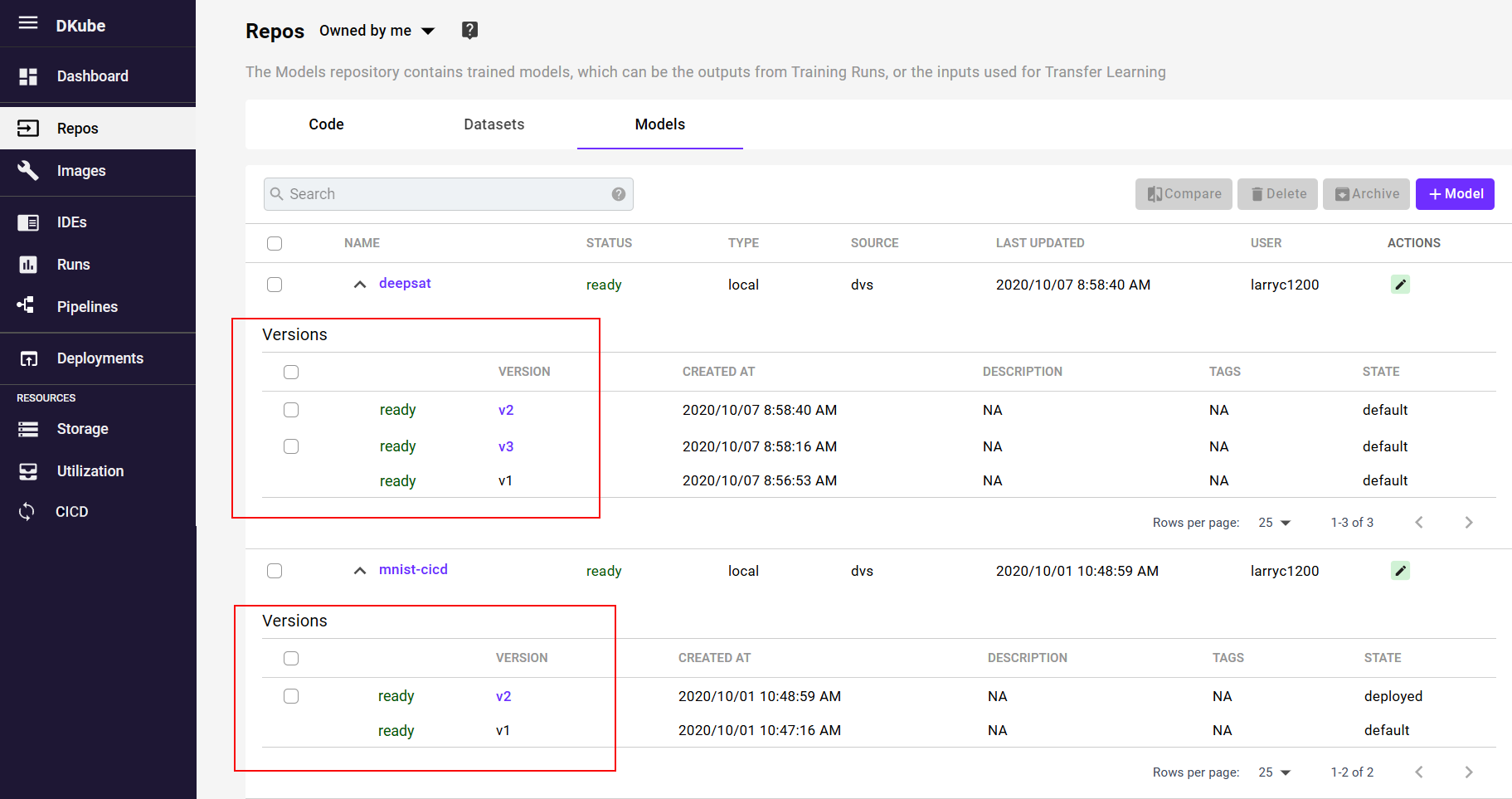
Model Details¶
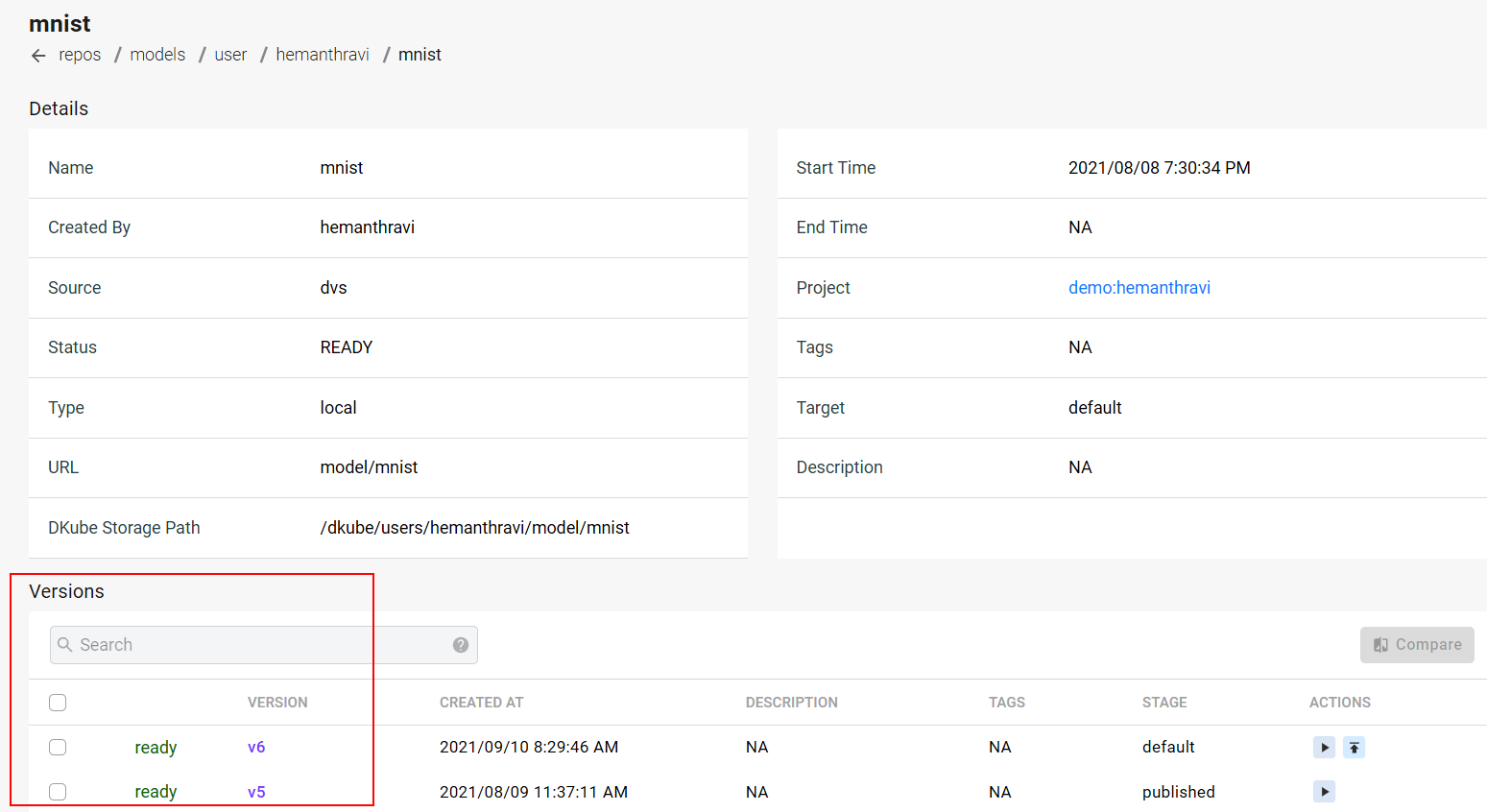
Selecting the Model will call up a screen which provides more details. This includes the information used to create the model and a list of versions. See section Versioning to understand how Model versions are created.
Model Version Lineage¶
More detail on a specific model version can be obtained by selecting that version on the detail page. The complete Model lineage can be viewed by selecting the “Lineage” tab on the Model Version Details screen. This provides the complete set of inputs that were used to create the Model.
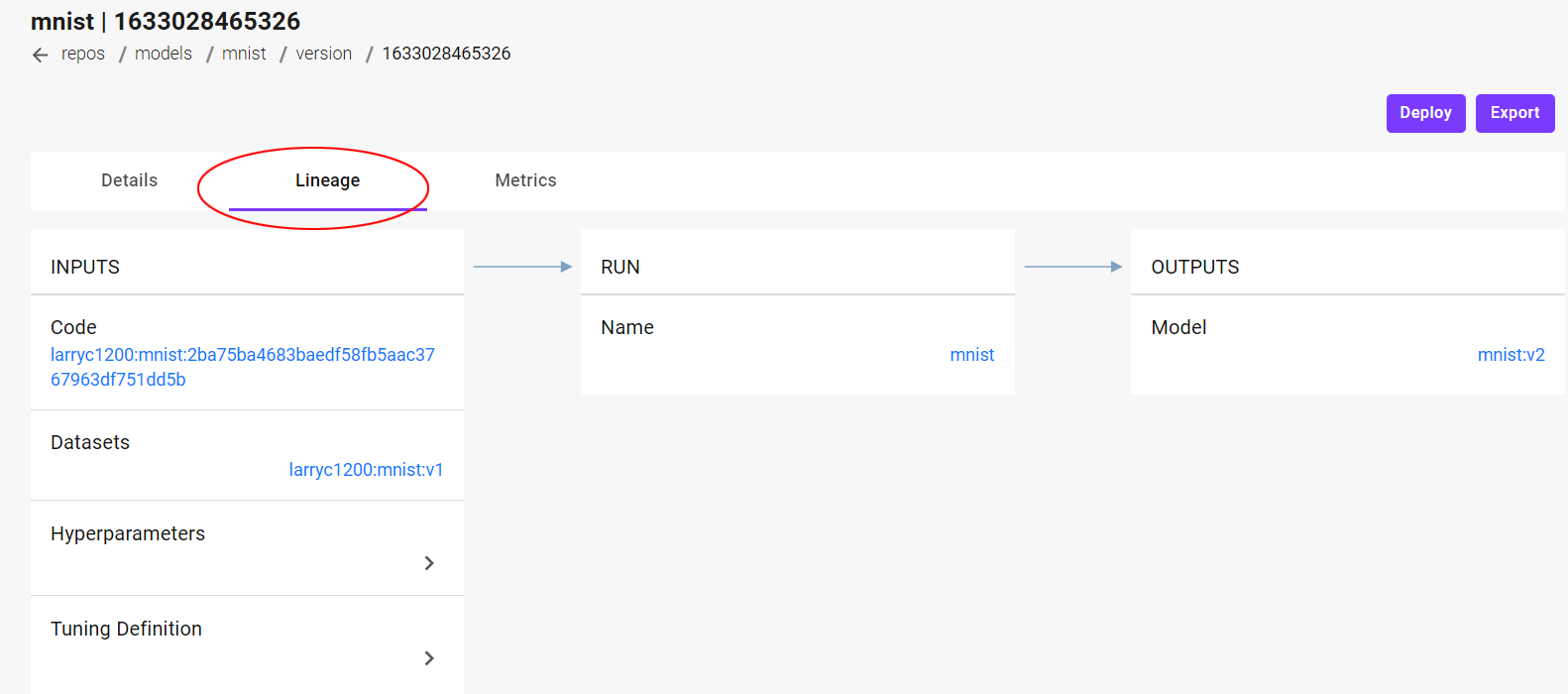
Add a Model¶
Models are added manually for 2 different purposes:
The Model is going to be used as an input to a Run for transfer learning, where a partially trained model is further trained
The Model will become an output from a Training Run
The screens and fields for adding a Model are the same as for adding a Dataset, described at Add a Dataset
Model Workflow¶

The overall workflow of a Model is described in section MLOps Concepts . A diagram of the flow is shown here. This describes the expected stages that a Model goes through from creation to production. This section provides the details of this workflow within DKube.
Compare Models¶
Model versions can be compared from:
The main model screen
The detailed model screen
To perform a comparison, the models to be compared should be selected, and the “Compare” button should be used. This will bring up a window with the comparison. The compare function is used by the Data Scientist and ML Engineer during their development.
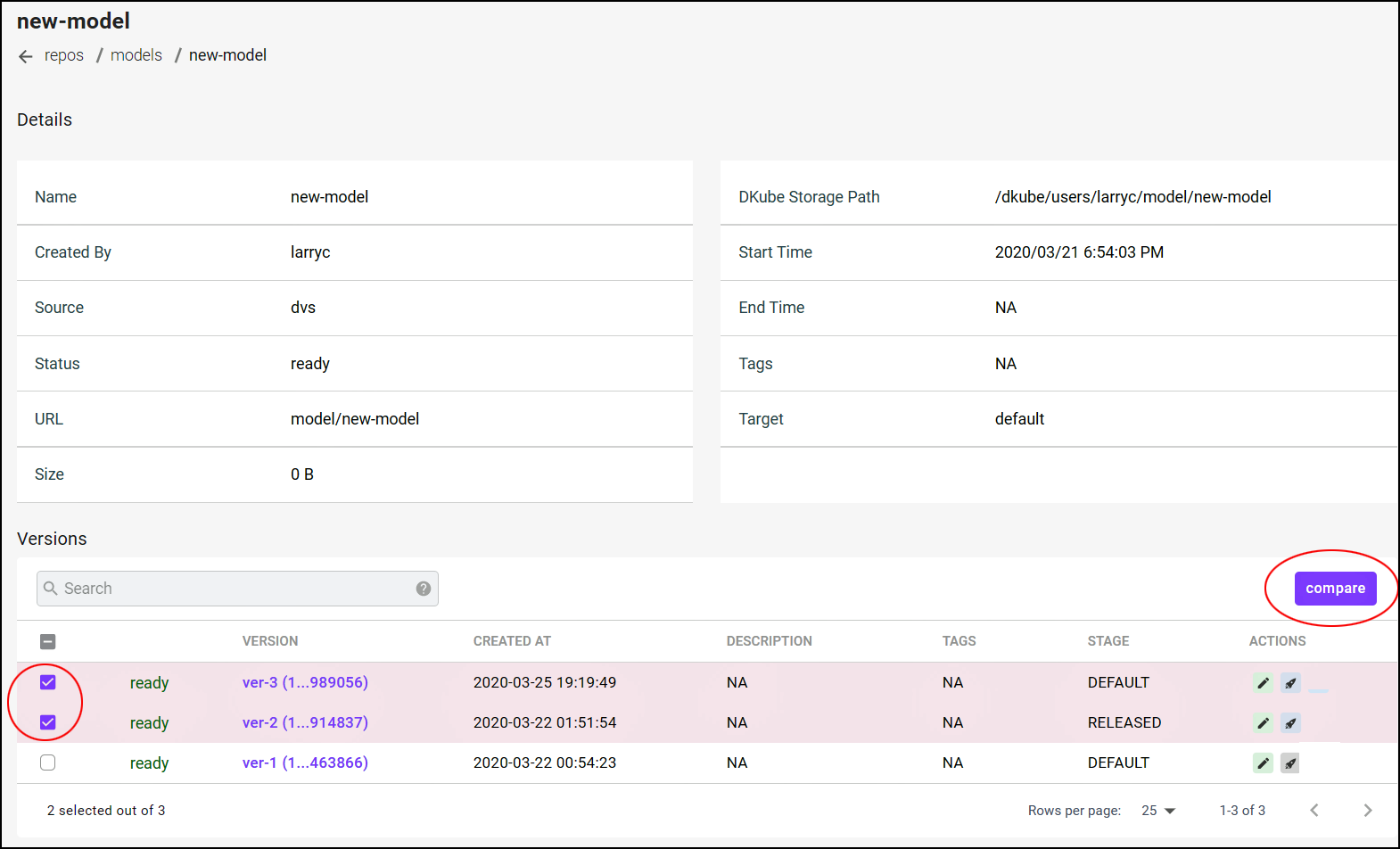
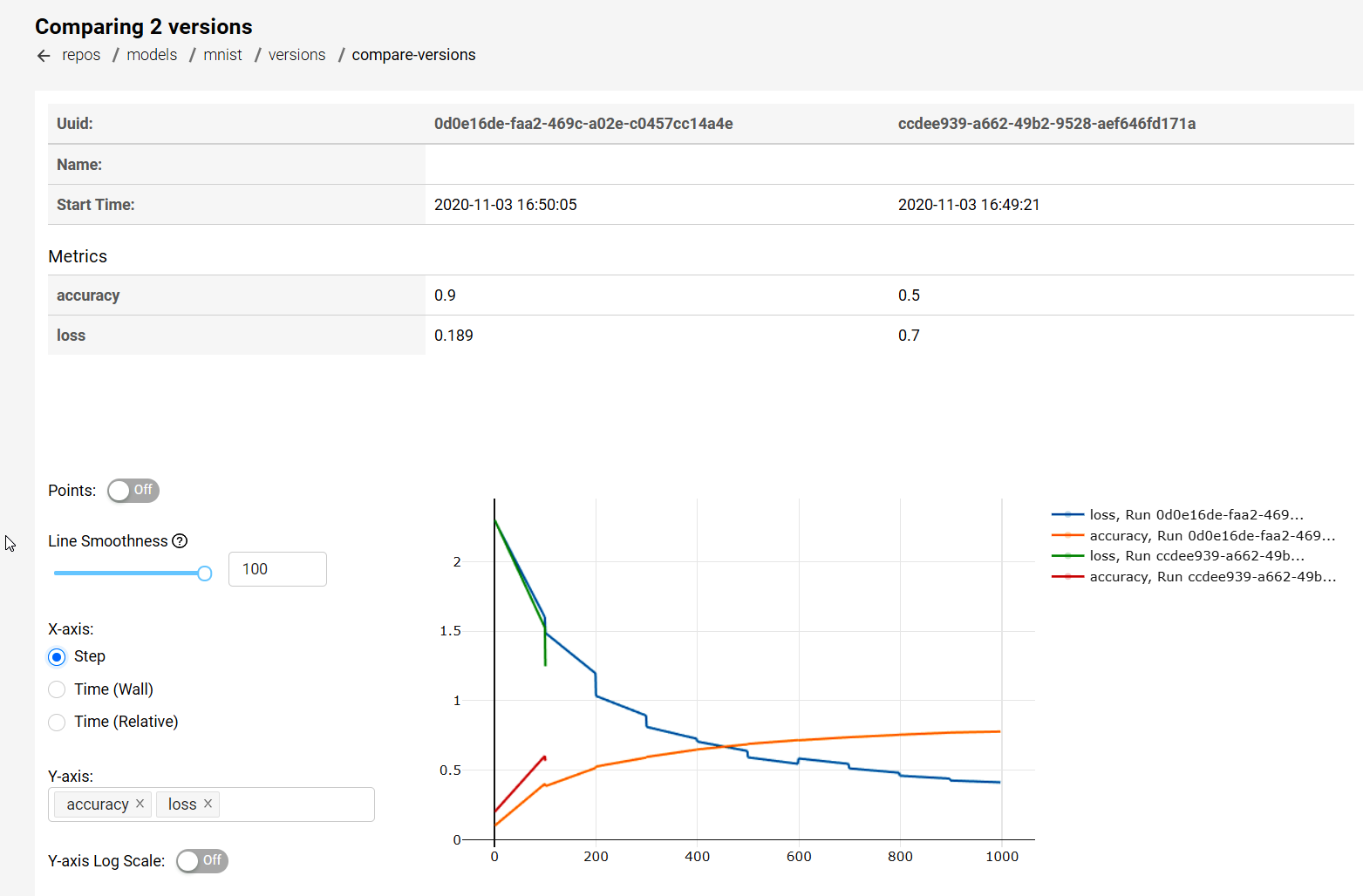
Model Actions¶
Models can have a variety of different actions performed on them from the details screen. The actions depend upon the User role as described at DKube Roles & Workflow .

Edit Model¶
The description and tag can be modified using the “Edit” button.
Deploy Model¶
A model can be deployed for local or production serving from the model detail screen. This will create an endpoint that can be exposed for inference. This is accomplished by selecting the Deploy icon on the Model versions screen.
A popup will appear to fill in the necessary deployment details.

Field |
Value |
|---|---|
Name |
User-chosen name for the Deployment |
Description |
Optional user-chosen name to provide more details for the Deployment |
Deployment |
Type of deployment - if Production is selected, the instances are launched on the production nodegroup defined during installation. If no production nodegroup is defined, the instance will be run on any node in the cluster. |
Serving Image |
Defaults to the training image, but a different image can be used if required |
Private |
Select if credentials are required |
Transformer |
Select if the deployment requires preprocessing or postprocessing |
Transformer Image |
Image used for the transformer code |
Transformer Code |
Defaults to the training code repo, but a different repo can be used if required |
Commit ID |
Commit ID for the Transformer Code - if left blank it will choose the latest |
Transformer Script |
Program used for the Transformer - referenced from the top level of the GitHub Code repository |
CPU/GPU |
Type of inference |
Minimum Replicas |
Minimum number of inference pods that will run in the idle state with no inference requests (https://knative.dev/docs/serving/autoscaling/scale-bounds/) |
Maximum Concurrent Requests |
Soft target for the number of concurrent requests that a single inference pod can serve for the Model (https://knative.dev/docs/serving/autoscaling/concurrency/) |

Change Model Deployment¶
After a Model has been deployed, it is associated with an endpoint URL. The Model associated with that endpoint can be changed from the Deployments screen. Select the Edit Action button to the right of the Model name. This will cause a Popup to appear that allows the Model version and other associated information to be changed for that endpoint.
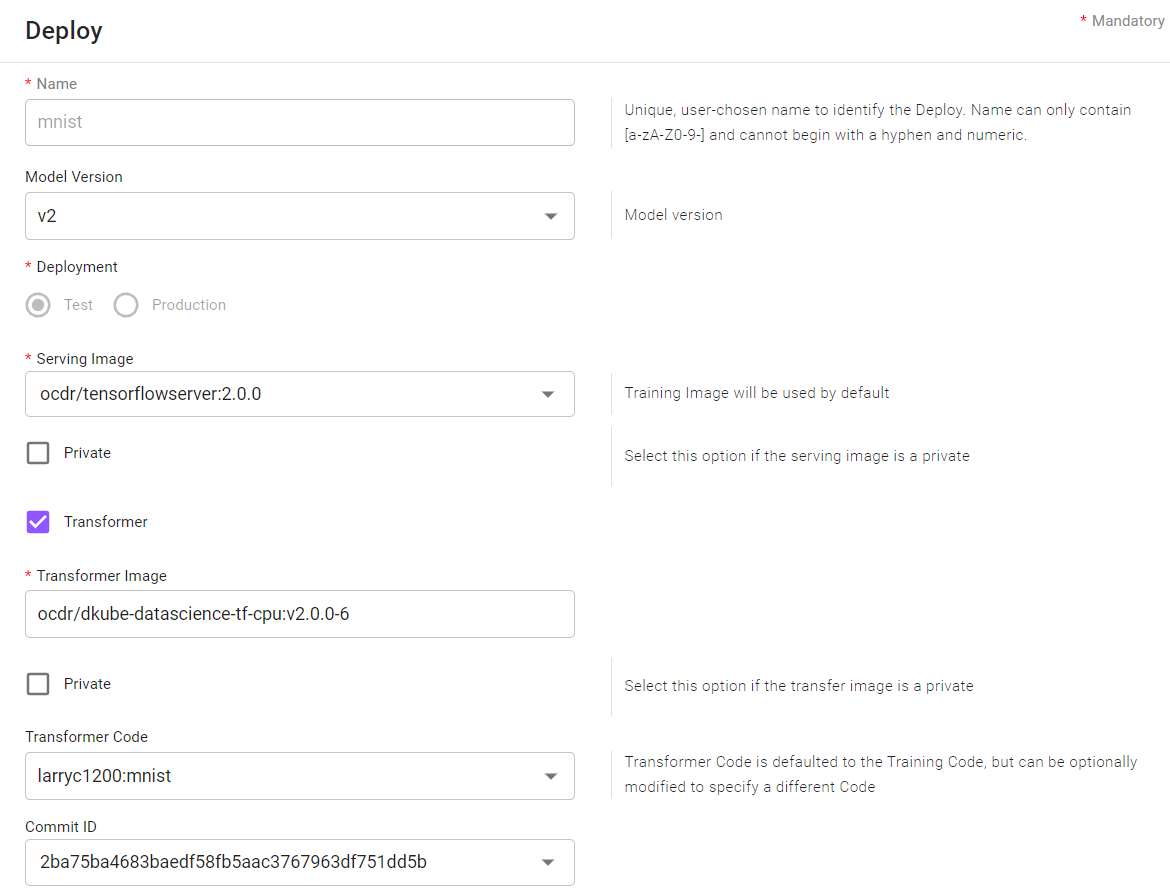
IDEs¶
DKube supports JupyterLab and RStudio. It can include the model and dataset information, as well as the hyperparameters for the model run.

The status messages are described in section Status Field of IDEs & Runs
TensorBoard¶
TensorBoard can be accessed from the Notebook screen.
Note
When an IDE instance is created, TensorBoard is in the “stopped” state. In order to use it, TensorBoard must be started by selecting the play icon (item 2 in the screenshot above).
Note
It can take several minutes for TensorBoard to be active after being started
Note
It is good practice to stop TensorBoard instances if they are not going to be used in order to conserve system resources
IDE Actions¶
There are actions that can be performed on an IDE instance (items 1 in the screenshot above).
A JupyterLab or RStudio instance can be started
A Training Run can be submitted based on the current configuration and parameters in the IDE.
In addition, there are actions that can be performed that are selected from the icons above the list of instances (item 3 in the screenshot). For these actions, the instance checkbox is selected, and the action is performed by choosing the appropriate icon.
An instance can be stopped or started
Instances can be deleted or archived (see Delete and Archive )
A new instance can be created by either cloning it (clone icon), or starting from a blank configuration (+ RStudio or + JupyterLab icon)
IDE Details¶
More information can be obtained on the Notebook by selecting the name. This will open a detailed window.
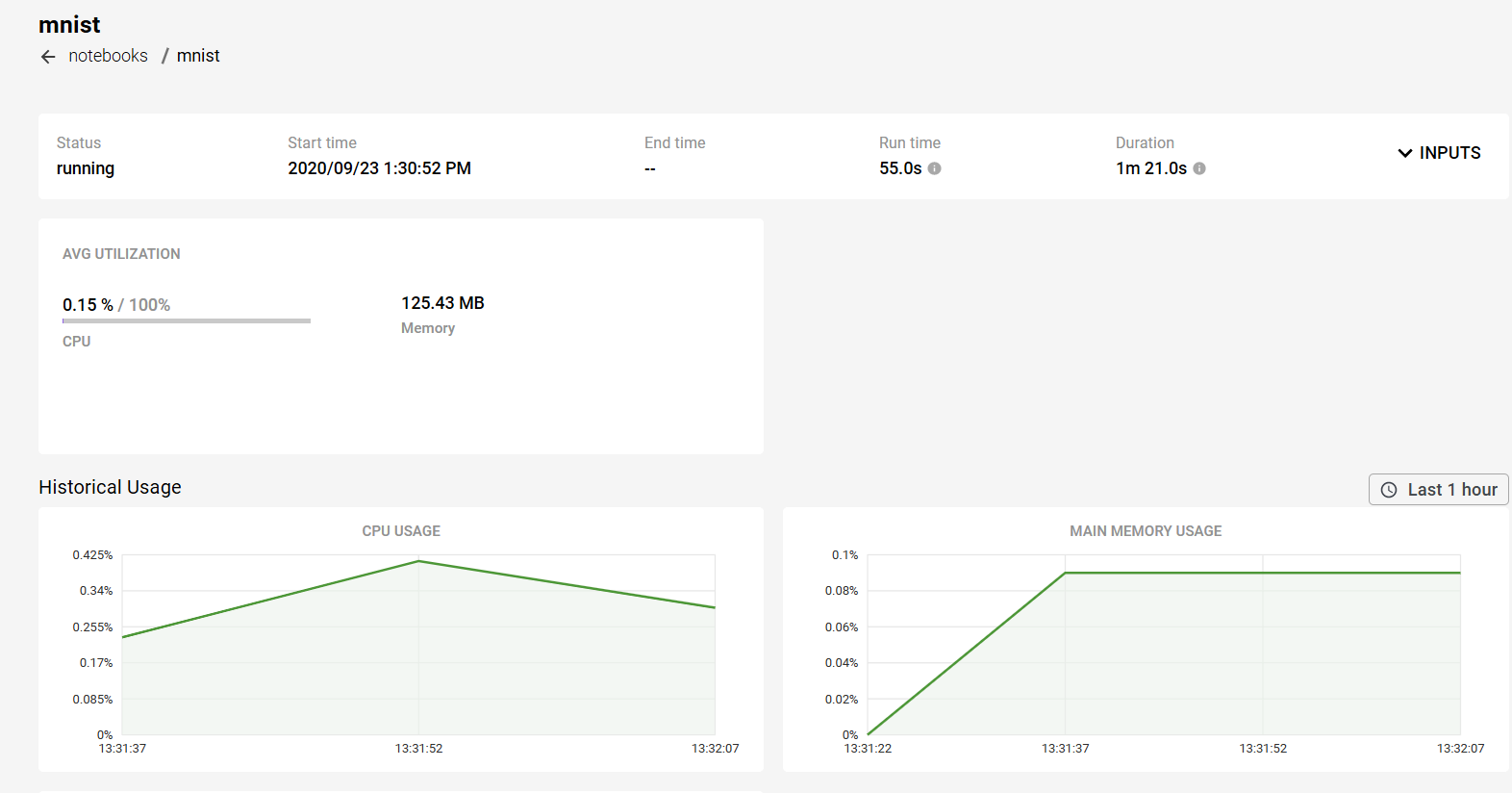
Create IDE¶

There are 2 methods to create an IDE instance:
Create a new JupyterLab or RStudio instance by selecting the “+ <Instance Type>” button at the top right-hand side of the screen, and fill in the fields manually
This is typically done for the first instance, since there is nothing to clone
Clone an instance from an existing instance
This will open the same new submission dialog screen, but the fields are pre-loaded from the existing instance. This is convenient when a new instance will have only a few different fields, such as hyperparameters, from an existing one.
In both cases, the new instance submission screen will appear. Once the fields have been entered or changed, select “Submit”
There are 3 sections that provide input to the new instance.
The Basic tab allows the selection of:
The name of the instance and any other pertinent information
The program code
The framework and version
The docker image to use: either the standard DKube image or your own custom image
The Repo tab selects the input datafiles required
The Configuration tab selects:
Inputs related to configuration files & hyperparameters
GPU requests
Note
It is not required to make changes to all of the tabs. There are some mandatory fields required, which are highlighted on the screen, but once those have been filled in the instance can be created through the Submit button. The tabs can be selected directly, or the user can go back and forth using the navigation buttons at the bottom of the screen.
Note
The first Run or instance load will take extra time to start due to the image being pulled prior to initiating the task. The message might be “Starting” or “Waiting for GPUs”. It will not happen after the first run of a particular framework version.
File Paths for Datasets and Models¶
The Dataset & Model repos that are added as part of the submission are saved as described at File Paths
Basic Submission Screen¶
Field |
Value |
|---|---|
Name |
Unique user-chosen identification |
Description |
Free-form user-chosen text to provide details |
Tags |
Optional, user-chosen detailed field to allow grouping or later identification |
Code |
Project code repo |
Framework |
Framework type |
Framework Version |
Framework version |
Image |
Docker image to use - this can be left at the default, or a custom image can be selected |
Code Repo¶
The code is uploaded into the local DKube storage and used for the IDE.
Important
The latest version of the product code will always be used. This is the case even if there is a specific commit ID filled in. The commit ID will be ignored.
DKube has built-in support for TensorFlow, PyTorch, and Scikit Learn.
Custom Containers¶
Custom containers are supported to extend the capabilities of DKube. In order to use a customer container within DKube, select “Custom” from the Framework dropdown menu. This will provide more options.
Enter the image location in the field labeled Docker Image URL in the format registry/<repo>/<image>:<tag>
If the image is in a private registry, enable the Private option, and fill in the username and password
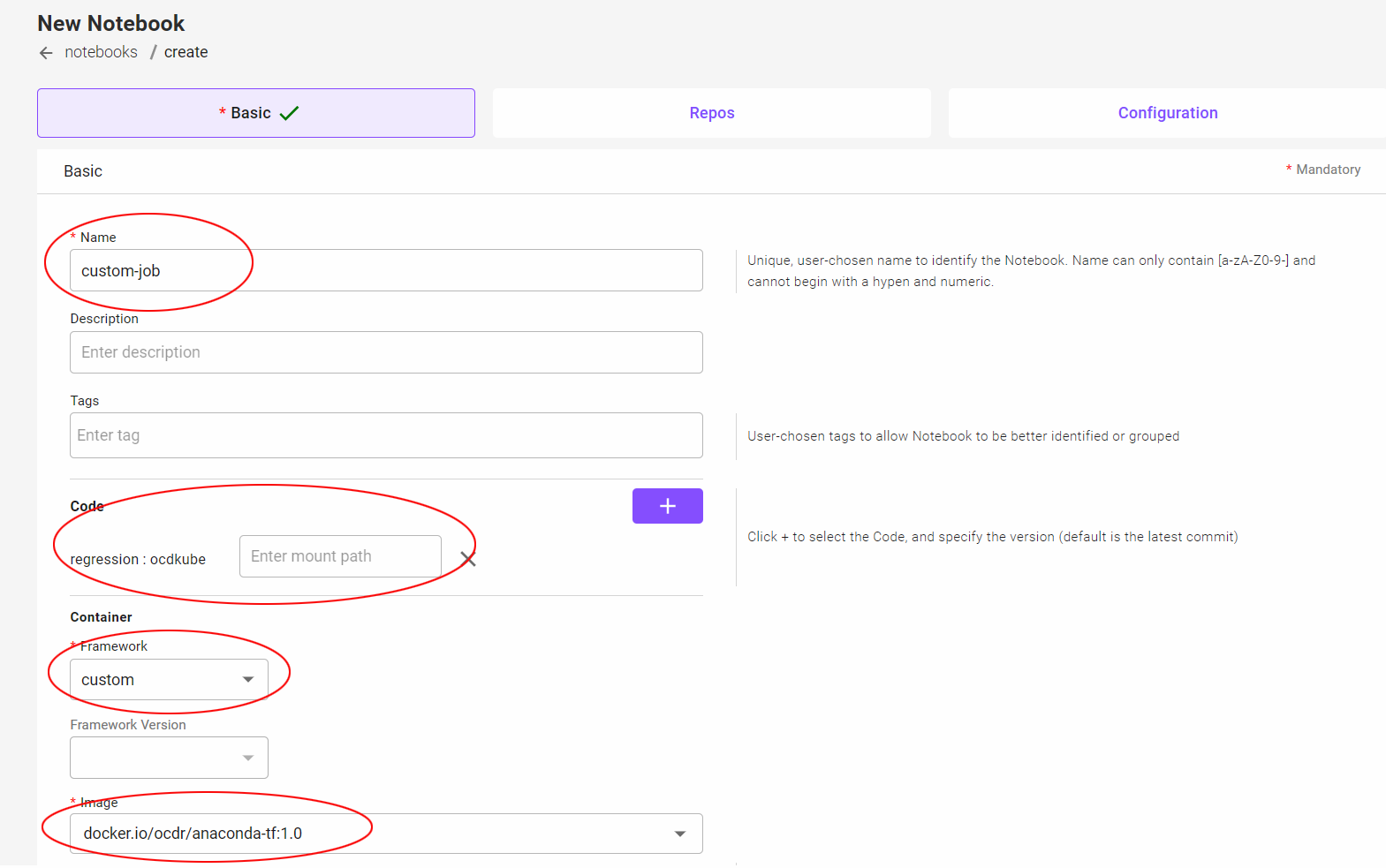
Repo Submission Screen¶
The Repos submission screen selects the repositories required for training or experimentation:
Dataset repo(s)
Model repo(s) for use in transfer learning

A repo is chosen by selecting the “+” beside the repo type, and choosing the repo(s) from the list provided. The repo is required to be made available to DKube through the process described in Repos
The version of the repo can also be chosen
A mount path should be selected for the repo, which should correspond to the expected path in the Project code. This is described in more detail at Mount Path
Mount Path for Datasets and Models¶
The Dataset, FeatureSet, & Model repos that are added as part of the submission contain a field called the “Mount Path”. This is the path that is used by the code to access the repo. This is described in more detail at File Paths
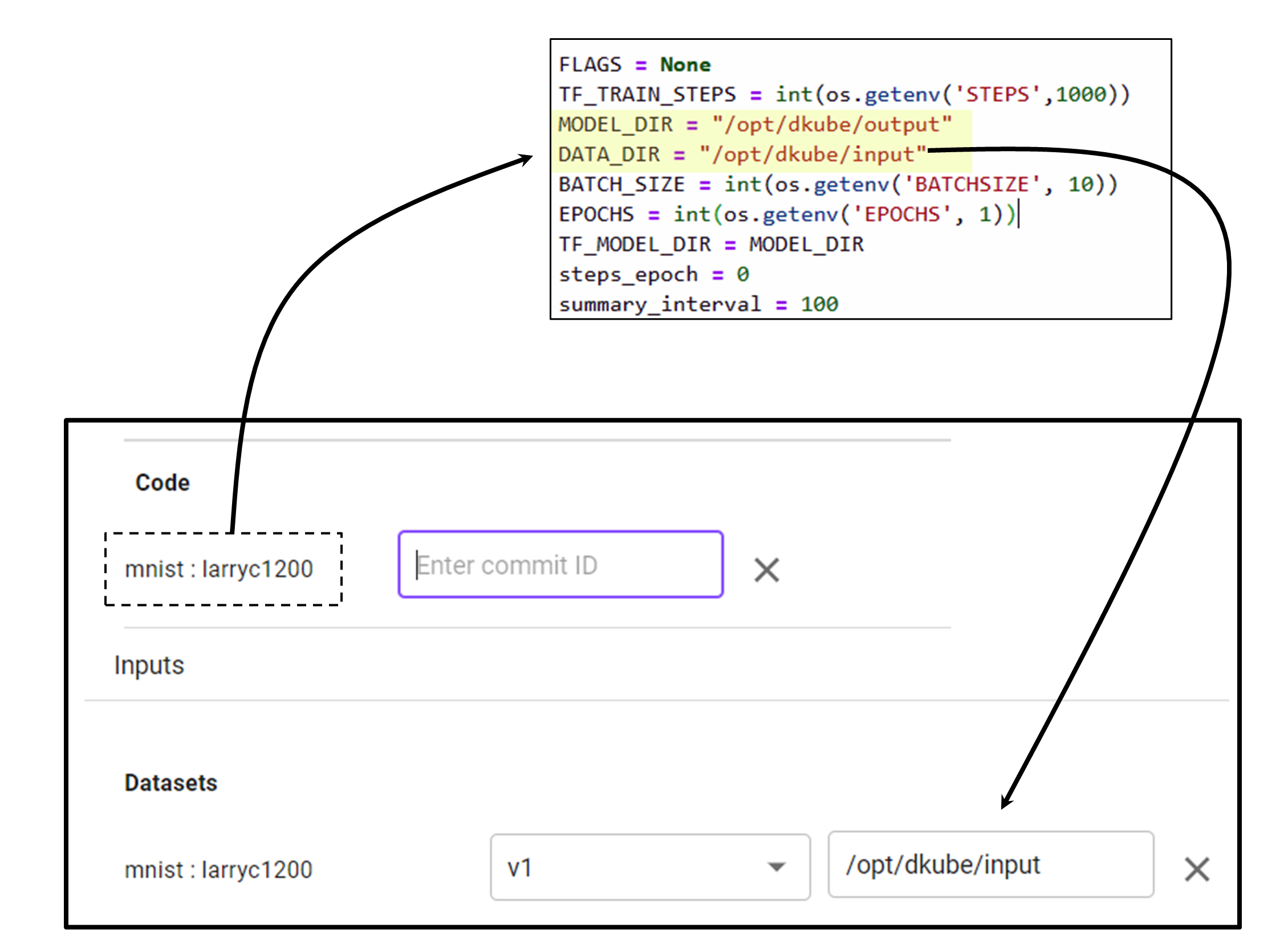
Configuration Screen¶
Configuration File¶
A configuration file can be uploaded and provided to the program. There is no DKube-enforced formatting for this file. It can be any information that needs to be used during program execution. It can be a set of hyperparameters, or configuration details, or anything else. The program needs to be aware of the formatting so that it can correctly unpacked during execution.
The file can be used within DKube as described in Configuration File
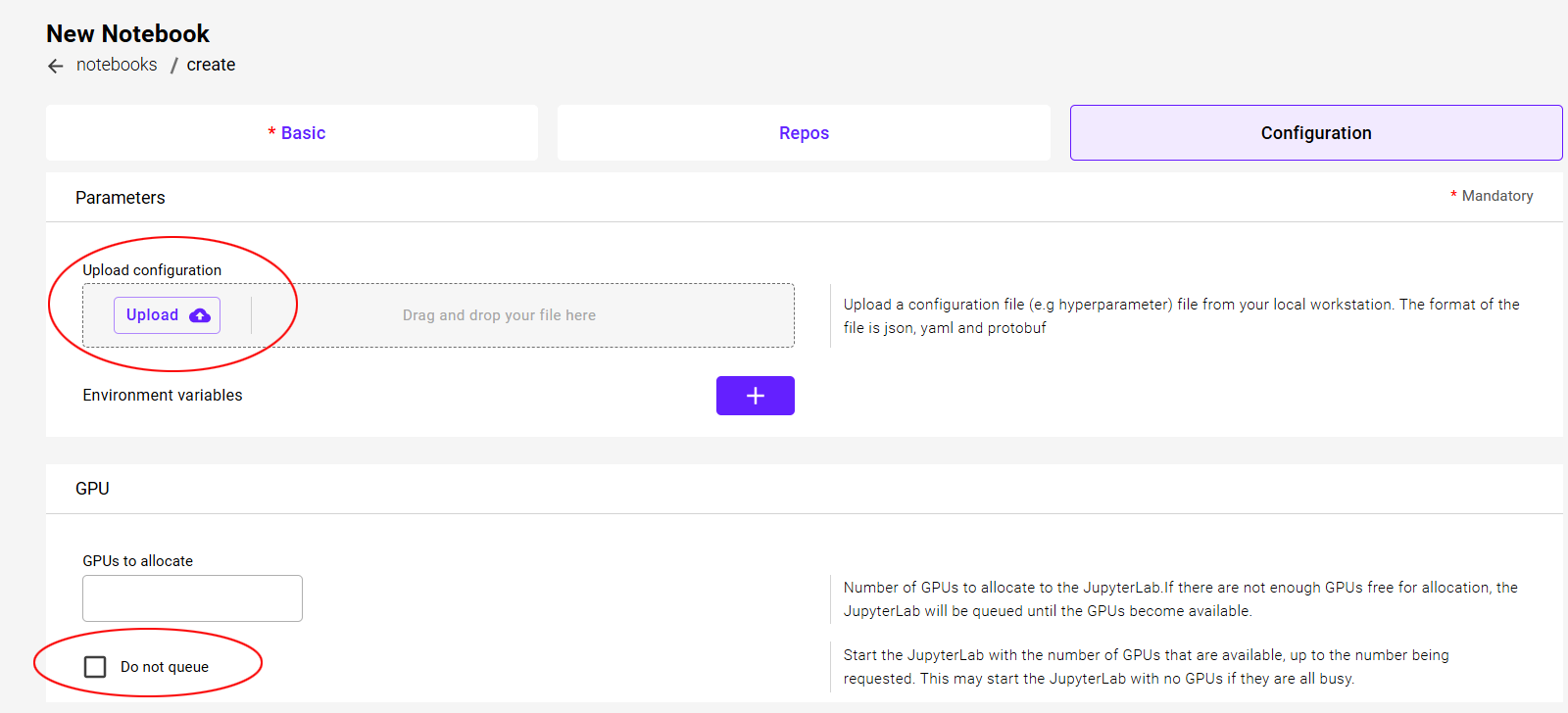
Hyperparameters¶
The configuration section allows the user to input the hyperparameters for the instance. The use of the hyperparameters is based on the program code. Hyperparameters can be added by selecting the highlighted “+”. This will allow an additional “Key” and “Value”. More parameters can be added by repeated use of this option.
GPUs¶
The number of GPUs can be selected for the instance. The GPUs in a Group are shared with all Users in a Group. If there are currently not enough GPUs to satisfy the request, the instance will be queued until enough GPUs are available.
The GPU selection area shows how many GPUs are available in the group. Selecting more GPUs than are available in the group will cause an error.
Note
The screen shows how many GPUs available in the Group, but these are shared with other instances and users. The actual number of GPUs available when the instance is submitted may be fewer than what is shown.
Just below the GPU selection is a checkbox that allows the instance to start with the number of GPUs that are available upon submission, including none, if all of the GPUs are currently in use. This will guarantee that the instance does not queue.
Delete IDE¶
Select the instance name from the left-hand checkbox
Click “Delete” icon at top right-hand side of screen
Confirm the deletion
Runs¶

A Run is the execution of code using:
Datasets
Optional pre-trained models
Hyperparameters
Resources
The status messages are described in section Status Field of IDEs & Runs
The Run screen allows the user to manage training and preprocessing based on the inputs selected. The primary difference between the functions are:
Once the Training Run is complete, it creates a trained Model
When a Preprocessing Run is complete, it creates a new Dataset

Groups¶
Runs can be put into categories called Groups to allow them to be more easily viewed and managed. The definition of a Group is entirely up to the user. When a Run is submitted, it is placed in a selected Group, and can be viewed from the main Run menu under the Groups tab. There is a default Group available, and any Run not put into another Group is put in the Default Group.
Templates¶
Run Templates are a way to simplify the submission of Runs. They allow many of the fields to be pre-filled, similar to cloning a run from another run. For example, the user may want to do a number of runs with different hyperparameters or resources. A Template can be used to fill in the fields, then the updated hyperparameters or resources can be selected before submitting the new Run.
Training Runs¶
Training runs create Models as their output.
TensorBoard¶
TensorBoard can be accessed from the Runs screen.
When a Run instance is created, TensorBoard is in the “stopped” state. In order to use it, TensorBoard must be started by selecting the play icon.
Note
It can take several minutes for TensorBoard to be active after being started
Note
It is good practice to stop TensorBoard instances if they are not going to be used in order to conserve system resources
Training Run Actions¶
There are actions that can be performed on a Training Run instance. For these actions, the Run instance checkbox is selected, and the action is performed by choosing the appropriate icon.
Hyperparameter Optimization¶
DKube supports Katib-based hyperparameter optimization. This enables automated tuning of hyperparameters for a program and dataset, based upon target objectives. An optimization study is initiated by uploading a configuration file during the Training Run submission as described in Configuration Submission Screen
The study initiates a set of trials, which run through the parameters in order to achieve the objectives, as provided in the configuration file. After all of the trial Runs have completed, DKube provides a graph of the trial results, and lists the best hyperparameter combinations for the required objectives.
The optimization study is ready for viewing when the status is shown as “complete”. That indicates that the trials associated with the study are all complete. The output results of the study can be viewed and downloaded by selecting the Katib icon at the far right hand side of the Run line.
As described in section Configuration Submission Screen , an optimization Run is initiated by providing a YAML configuration file in the Hyperparameter Optimization field when submitting a Run.
A study that has been initiated using Hyperparameter Optimization is identified by the Katib icon on the far right.

Selecting the icon opens up a window that shows a graph of the trials, and lists the best trials based on the objectives.
Training Run Details¶
More information can be obtained on the Run by selecting the name. This will open a detailed window.
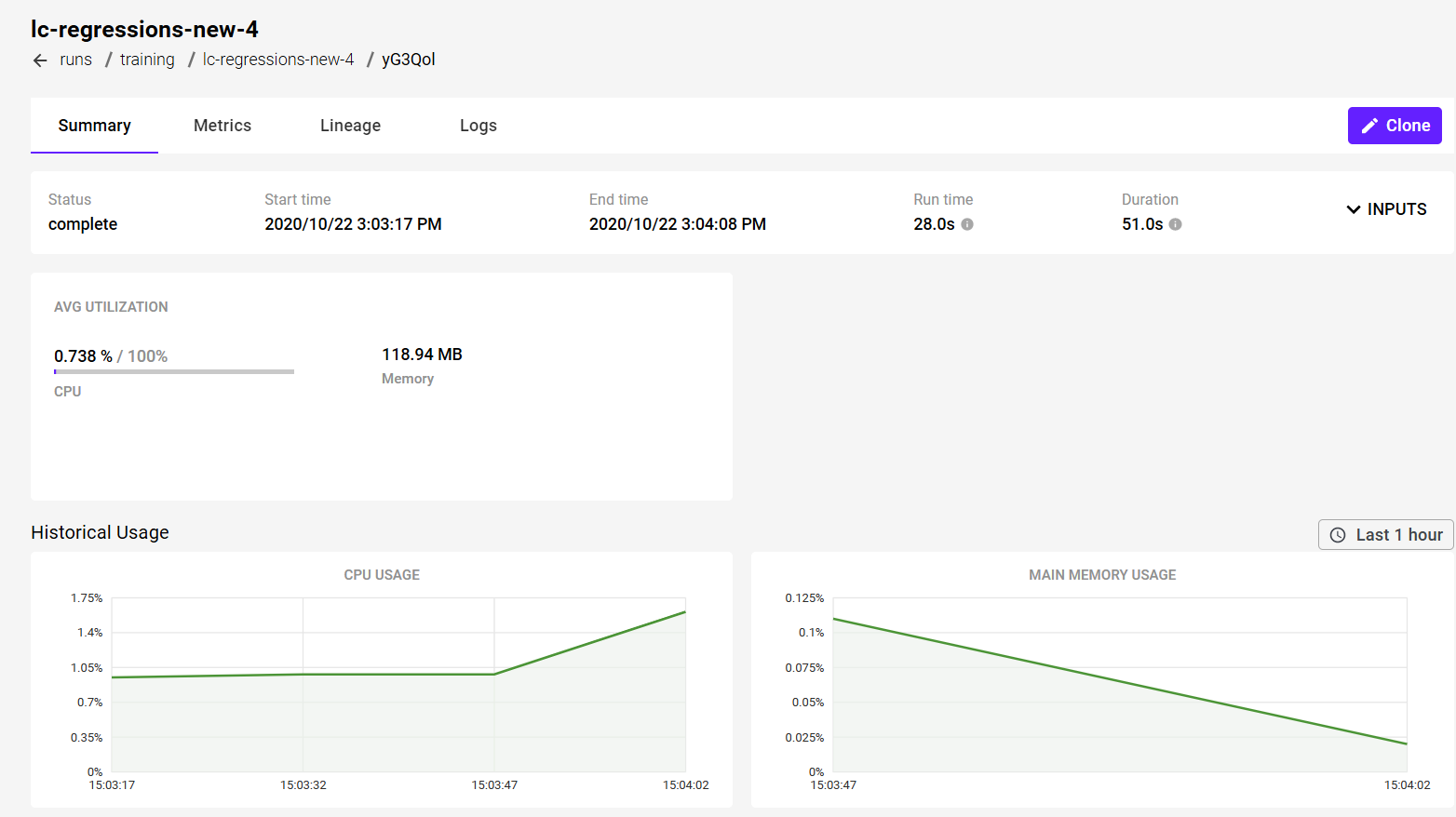
Lineage¶
DKube provides the complete set of inputs that are used to create a Model from a Training Run. The overall concept is described in section Tracking and Lineage . The lineage is accessed from the details screen for a Run.
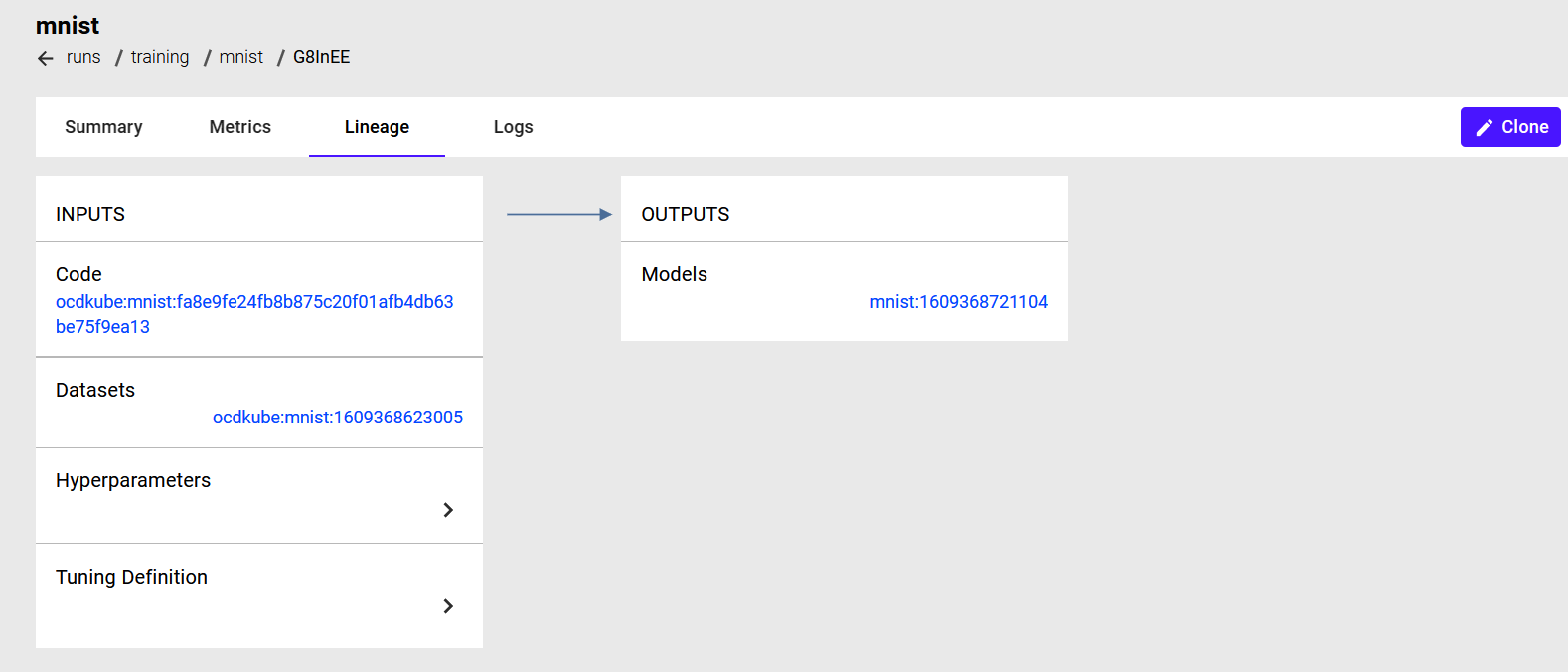
Compare Runs¶
Training runs can be compared in a similar manner as Model versions. This is accomplished by selecting the Runs to compare.

Create Training Run¶
A Training Run can be created in the following ways:
Create a Run from a JupyterLab or RStudio instance, using the “Create Run” icon on the right-hand side of the selected instance
This will pre-load the parameters from the instance
Create a new Training Run by selecting the “+ Run” button at the top right-hand side of the screen, and fill in the fields manually
The type of run, training or preprocessing, is chosen
A Run can be created from a Template at Templates that will pre-fill in many of the fields
Clone a Training Run from an existing instance
This will open the same new Training Run dialog screen, but most of the fields are pre-loaded from the existing Run. This is convenient when a new Run will have only a few different fields, such as hyperparameters, as the existing Run.
A Run is automatically created as part of a Pipeline
For the cases where a Run is created by the User, the “New Training Run” screen will appear. Once the fields have been filled in, select “Submit”.

Note
The first Run will take additional time to start due to the image being pulled prior to initiating the task. The message might be “Starting” or “Waiting for GPUs”. Each time a new version of the framework is run for the first time, the delay will occur. It will not happen after the first run.
File Paths for Datasets and Models¶
The Dataset & Model repos that are added as part of the submission are saved as described at File Paths
Basic Submission Screen¶
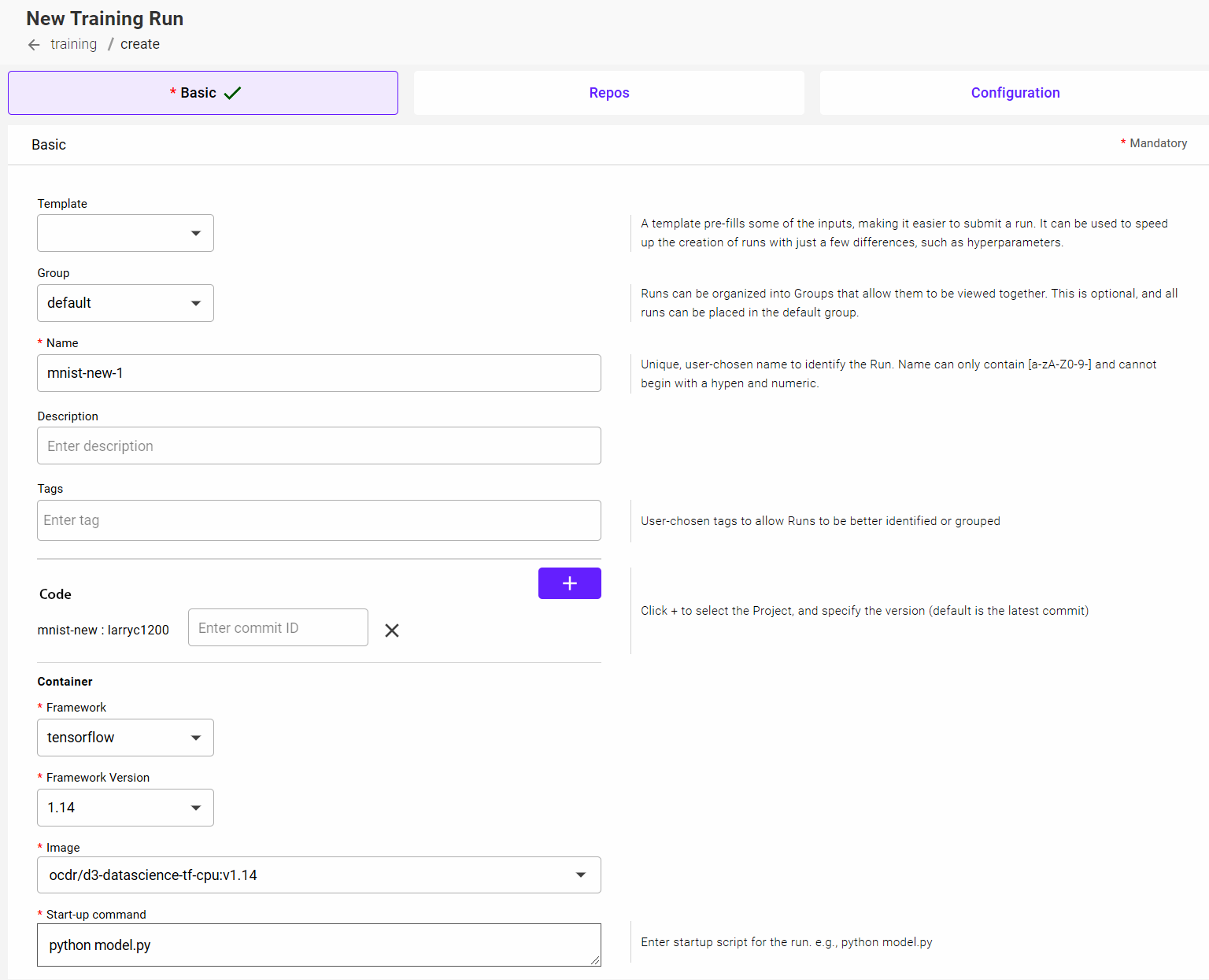
Field |
Value |
|---|---|
Name |
Unique user-chosen identification |
Description |
Free-form user-chosen text to provide details |
Tags |
Optional, user-chosen detailed field to allow grouping or later identification |
Code |
Program code repo |
Framework |
Framework type |
Framework Version |
Framework version |
Image |
Docker image to use - this can be left at the default, or a custom image can be selected |
Start-up Command |
Program and options that need to run in order to initiate training |
DKube has built-in support for TensorFlow, PyTorch, and Scikit Learn.
Code Repo¶
The code is uploaded into the local DKube storage and used for the Run.
The program code will be used based on the Commit ID field.
Blank |
The latest version of the code will be used |
Value |
The version of the code with that value will be used |
Custom Containers¶
Custom containers are supported to extend the capabilities of DKube. In order to use a customer container within DKube, select “Custom” from the Framework dropdown menu. This will provide more options.
Enter the image location in the field labeled Docker Image URL in the format registry/<repo>/<image>:<tag>
If the image is in a private registry, enable the Private option, and fill in the username and password
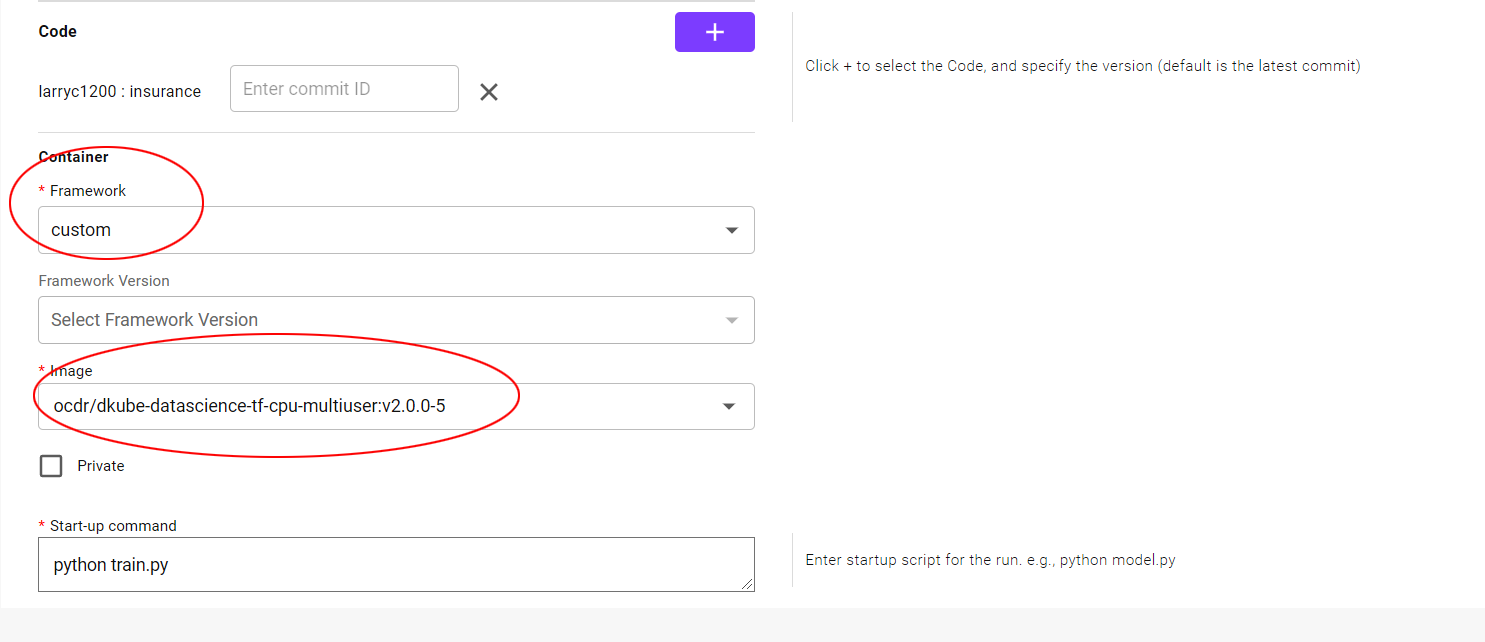
Build From Code Repo¶
By default, DKube will choose a standard image when creating a new training Run. If a different image is required, it can be selected from the dropdown menu in the Image field. In addition, the image can be created from the Code and then used for the Run.
In order to use this capability, the GitHub folder is required to have a .dkube-ci.yml file as described at CI/CD Image Creation
Selecting the “build-from-code-repo” Image option will cause the image to first be built and saved, then used for the Run execution.
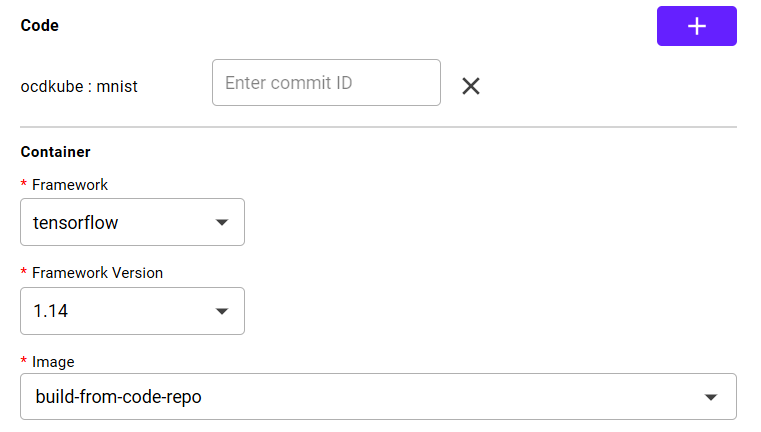
Repo Submission Screen¶
Output Model Repo¶
The Repos screen has an output Model section for the trained model in addition to the input Model section (for transfer learning).
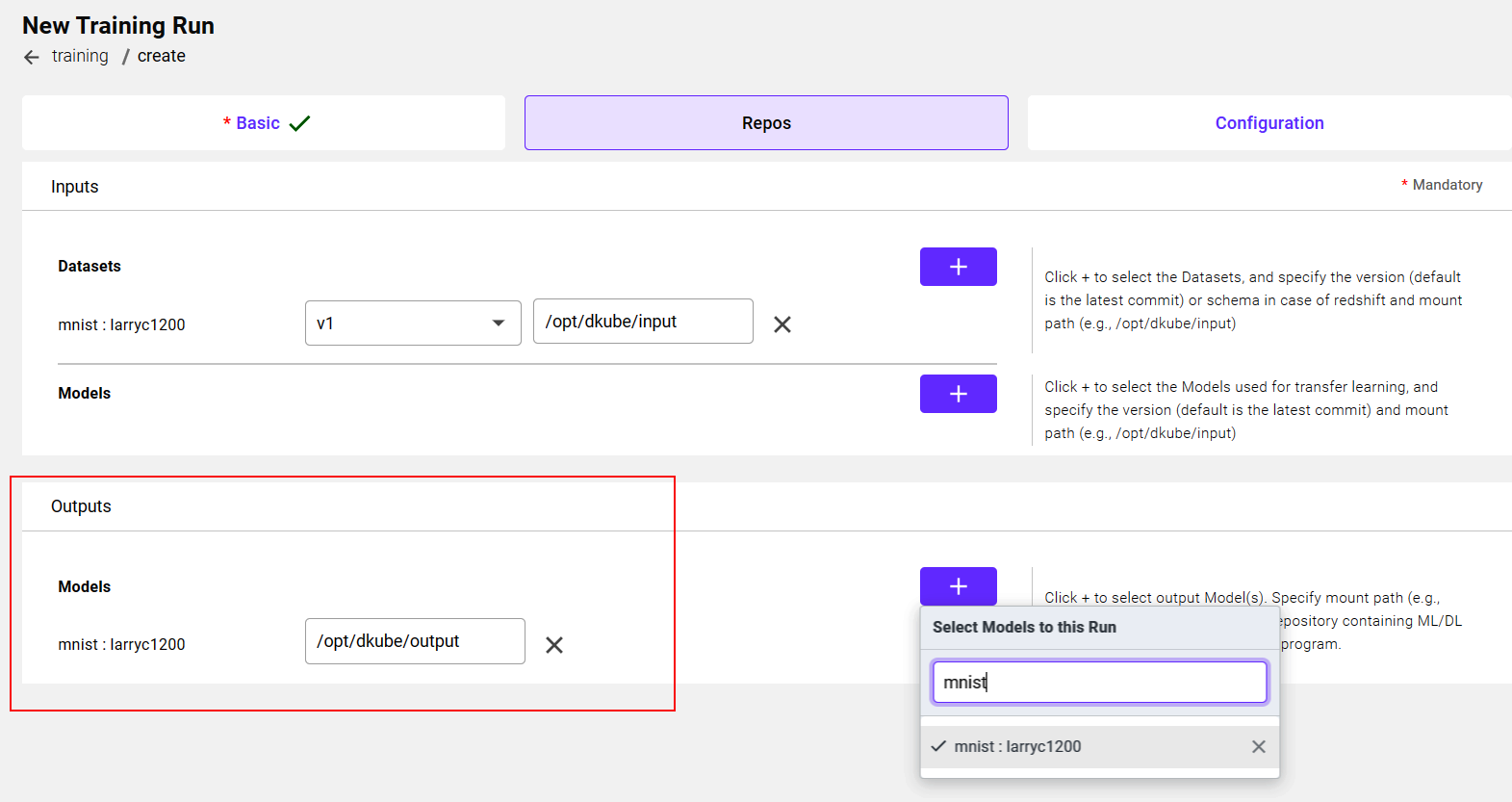
The format for the output Model is similar to the input Model. Even though the field is for an output trained model, there still needs to be an entry in the Models repo so that the model can be properly tracked and versioned. The new trained model will become the next version of the model that is added to the submission.
In order to create a completely new model - with Ver 1 - a new DVS model should be created as explained in the section Models
Configuration Submission Screen¶
Configuration File¶
A configuration file can be uploaded and provided to the program. There is no DKube-enforced formatting for this file. It can be any information that needs to be used during program execution. It can be a set of hyperparameters, or configuration details, or anything else. The program needs to be aware of the formatting so that it can correctly unpacked during execution.
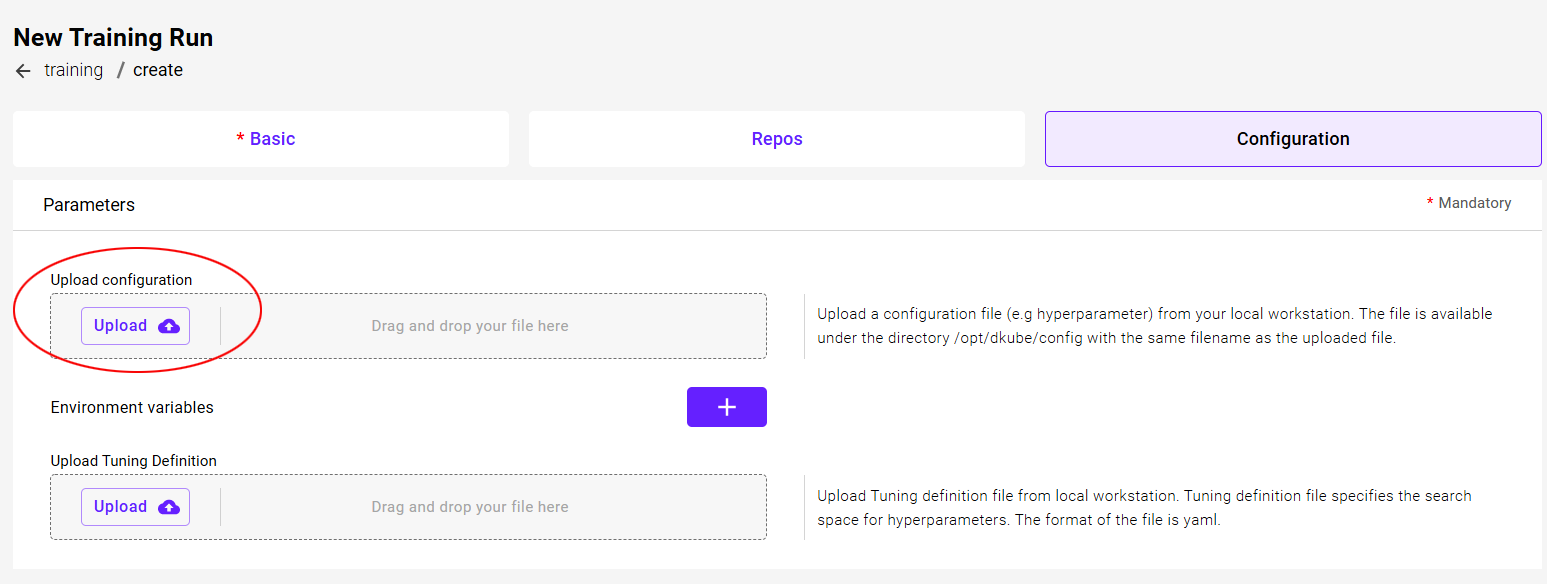
Hyperparameters¶
The configuration section allows the user to input the hyperparameters for the instance. The use of the hyperparameters is based on the program code. Hyperparameters can be added by selecting the highlighted “+”. This will allow an additional “Key” and “Value”. More parameters can be added by repeated use of this option.
Hyperparameter Tuning¶
The Configuration screen has additional fields that allow more actions for the Run beyond what is possible with an IDE.

In addition to the ability to add or upload hyperparameters, the Training Run can also initiate a Hyperparameter Optimization run.
In order to specify that the Run should be managed as a Hyperparameter Optimization study, a yaml file must be uploaded that includes the configuration for the experiment.
The YAML files for the examples that are included with DKube are available at the following links.
Example |
Hyperparameter File |
|---|---|
mnist |
https://oneconvergence.com/guide2/downloads/mnist-tuning-2.yaml |
catsdogs |
https://oneconvergence.com/guide2/downloads/catdog-tuning-2.yaml |
The YAML file should be downloaded locally, and used when submitting the Run. The YAML file can be edited to have different configurations.
Leaving this field blank (no file uploaded) will indicate to DKube that this is a standard (non-hyperparameter optimization) Run.
The format of the configuration file is explained at Katib Introduction.
GPU Distribution¶
Runs can be submitted with GPUs distributed across the cluster. The Project code needs to be written to take advantage of this option. In order to enable this, the “Distributed workloads” option needs to be selected.

The distribution can be accomplished automatically or manually.
If the automatic distribution option is selected, DKube will determine the most effective way to use the GPUs across the cluster.
If the manual distribution option is selected, the user needs to tell DKube how the GPUs should be distributed. For this option, the user needs to understand the topology of the cluster, and know where the GPUs are located.
When distributing the workload manually across nodes in the cluster, the number of workers needs to be specified. DKube takes the number of GPUs specified in the GPU field, and requests that number of GPUs for each worker.
So, for example, if the number of GPUs is 4, and the number of workers is 1, then 8 GPUs will be requested, spread across 2 nodes.
Stop Run¶
Select the Run to be stopped with the left-hand checkbox
Click the “Stop” icon at the top right-hand side of the screen
Preprocessing Runs¶
A Preprocessing Run outputs a Dataset entry when it is complete. This is typically done in order to modify a raw dataset such that it can be used for Training.

Create Preprocessing Run¶
A Preprocessing Run can be created in the following ways:

Create a new Preprocessing Run by selecting the “+ Run” button at the top right-hand side of the screen, and selecting “Preprocessing”.
A Run is automatically created as part of a Pipeline
For the cases where a Preprocessing Run is created by the User, the “New Preprocessing Run” screen will appear. Once the fields have been filled in, select “Submit”
Note
The first Run will take additional time to start due to the image being pulled prior to initiating the task. Each time a new version of a framework is run for the first time, the delay will occur. It will not happen after the first run.
Basic Submission Screen¶
In addition to the standard fields, including the name of the run, tags, and start-up command, the Preprocessing Basic screen includes a docker image field that points to the image created by the user.
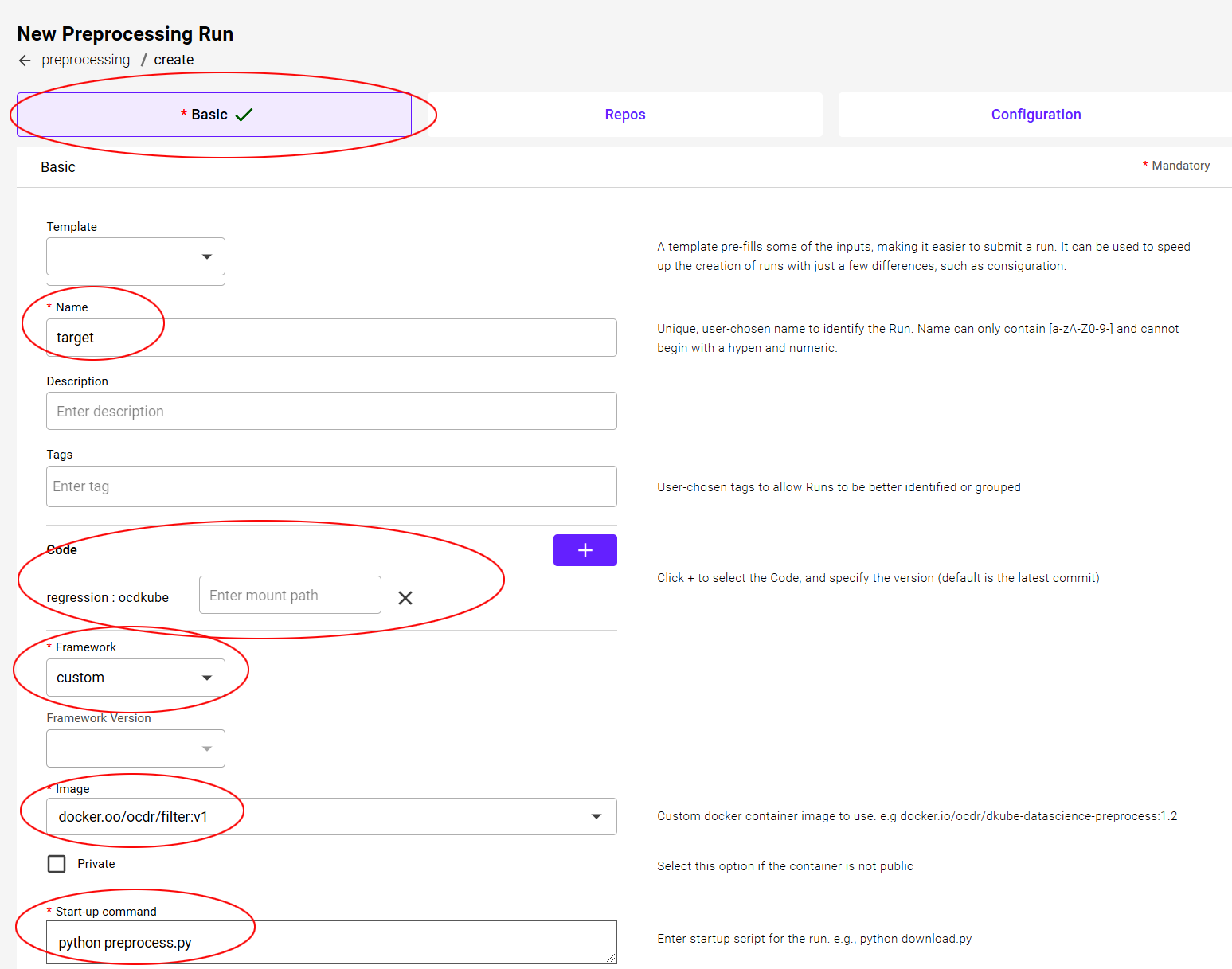
Repo Submission Screen¶
The Repos screen is filled in similarly to the Training Run, but instead of a Model output, there is a Dataset output.
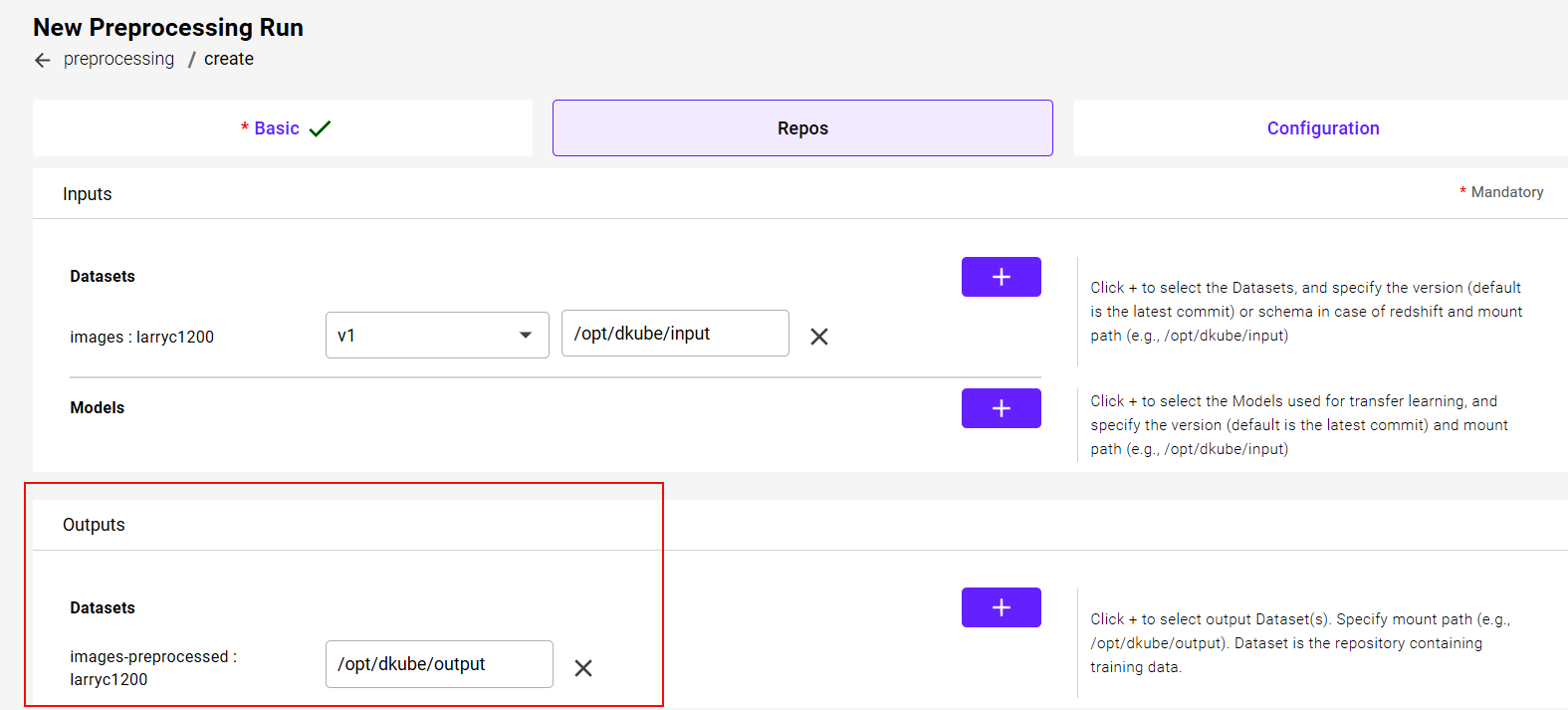
Kubeflow Pipelines¶
DKube supports Kubeflow Pipelines. Pipelines describe a workflow structure graphically, identifying the flow from one step to the next, and define the inputs and outputs between the steps.
An introduction to Kubeflow Pipelines can be found at Kubeflow Pipelines
One Convergence provides templates and examples for pipeline creation described at Kubeflow Pipelines Template
The steps of the pipeline use the underlying components of DKube in order to perform the required actions.
The following sections describe what is necessary to create and execute a Pipeline within DKube.
Upload a New Pipeline¶

The pipelines that have been uploaded or created within DKube are available from the “Pipelines” menu. There are a number of pipelines that come with a standard DKube installation. New pipelines can be uploaded to DKube by selecting the “+ Upload Pipeline” button and entering the access information.
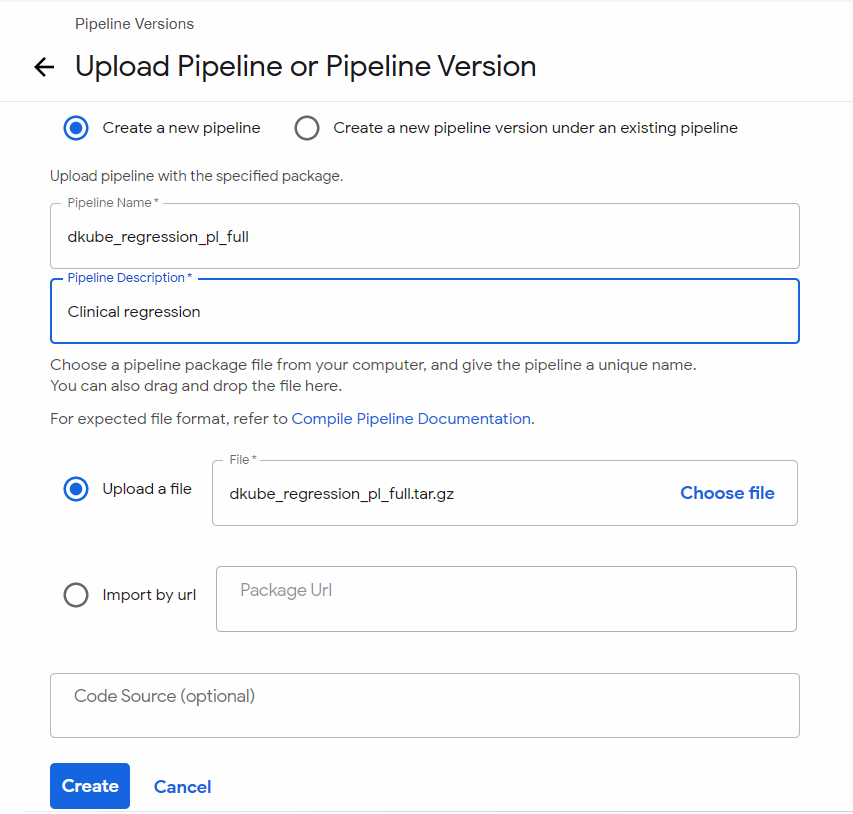
Create a Pipeline Run¶
A new Run can be created from a Pipeline by selecting the Pipeline name and choosing either a Run or an Experiment. The Experiment choice will put the Run into that Experiment.
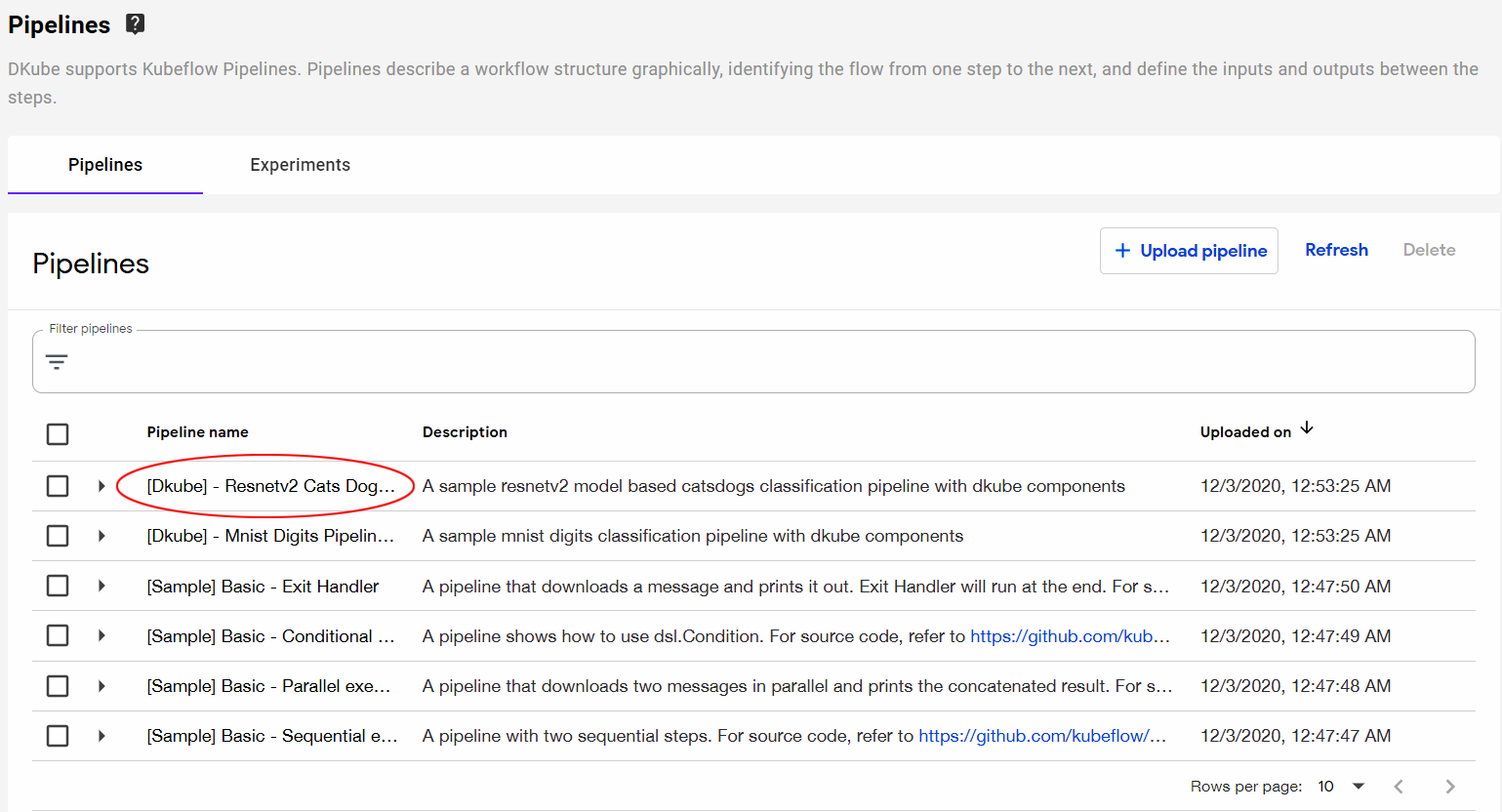
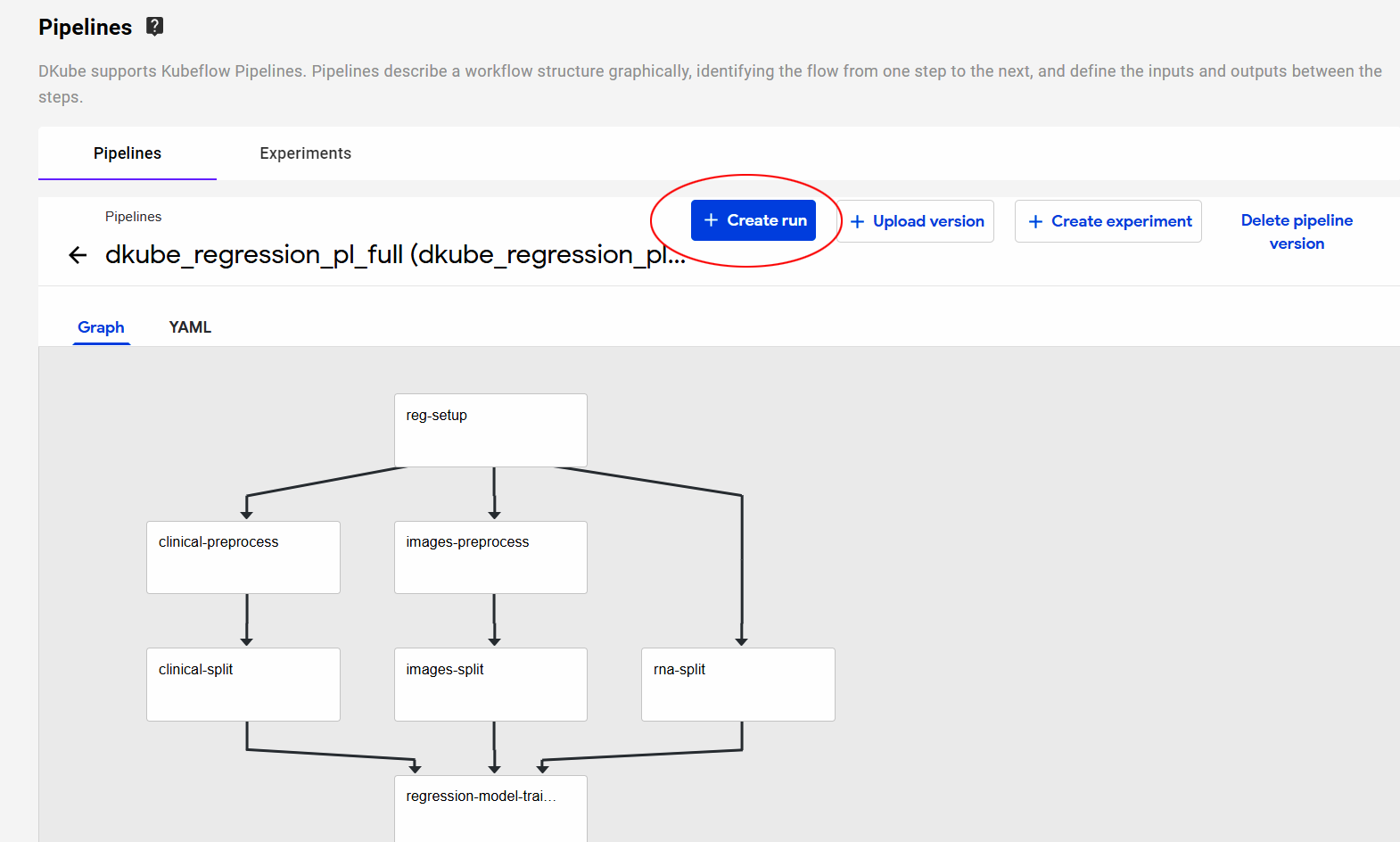
The top input fields are common to any pipeline. The Run Parameters are specific to the Pipeline.
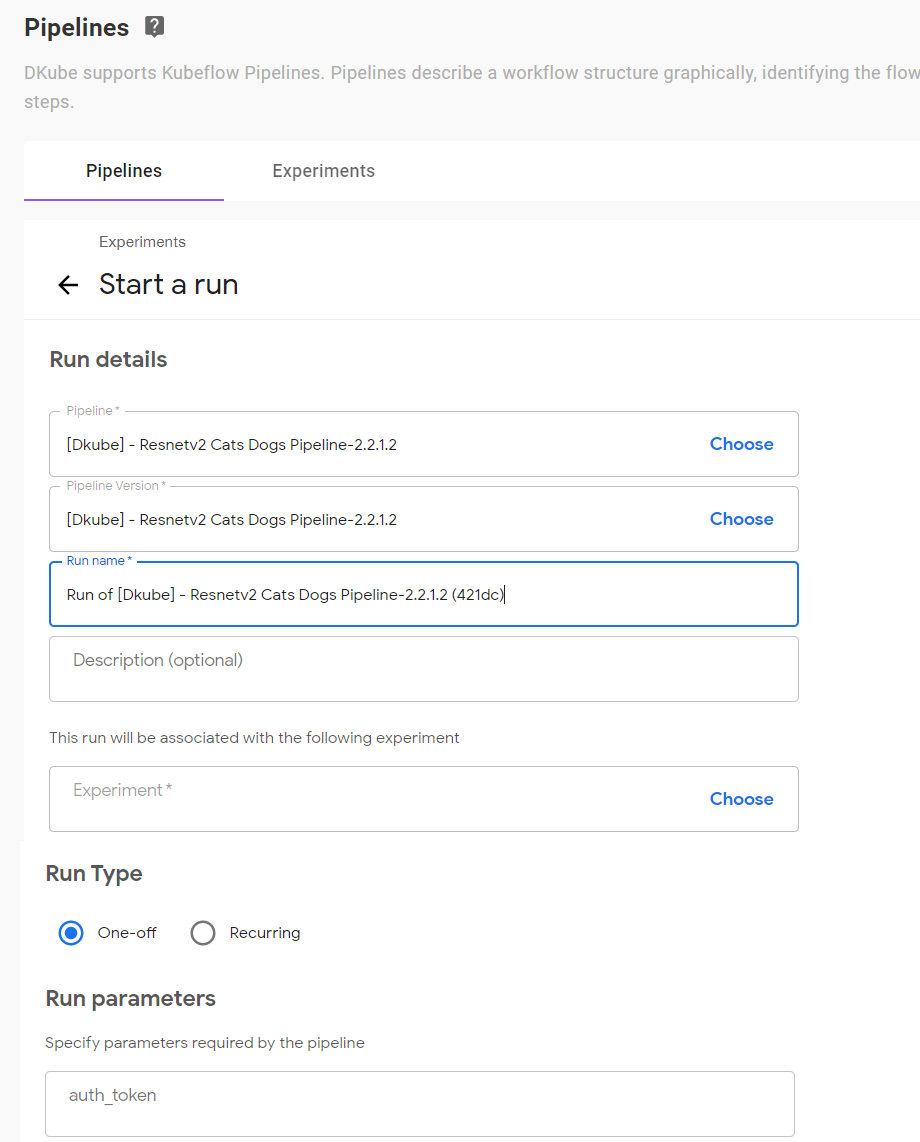
Field |
Description |
|---|---|
Pipeline |
Name of the Pipeline - defaults to Pipeline selected in previous step |
Pipeline Version |
Version of the Pipeline - defaults to Pipeline selected in previous setup |
Run name |
User-selected name for use in tracking |
Description |
Optional, user-selected field for providing more details |
Experiment |
Experiment to use for this Run |
Run Type |
Choose One-off or Recurring |
Run Parameters |
Input fields specific to the Pipeline |
Important
If the Run Type is selected as Recurring, there is a maximum number of 9 characters for the Run name
Manage Experiments and Runs¶
Experiments that have been created from pipelines are managed from the Experiments screen.

Within each experiment, the Runs that are part of that Pipeline are visible by selecting the Experiment name.

Selecting the name of the Run brings up the current state of the Pipeline. Selecting a Pipeline box within the “current state” screen brings up a window that provides more details on the configuration and status of the Run.
